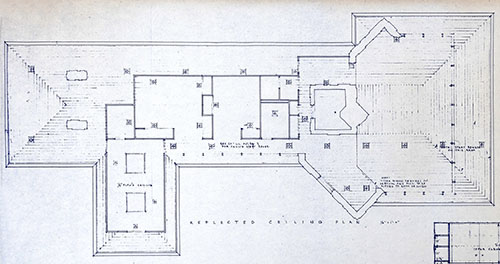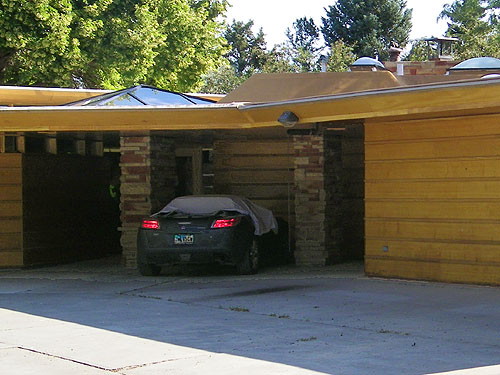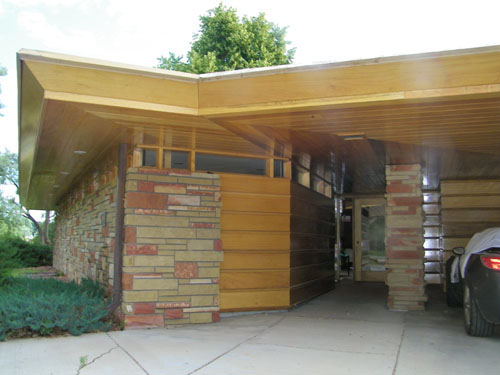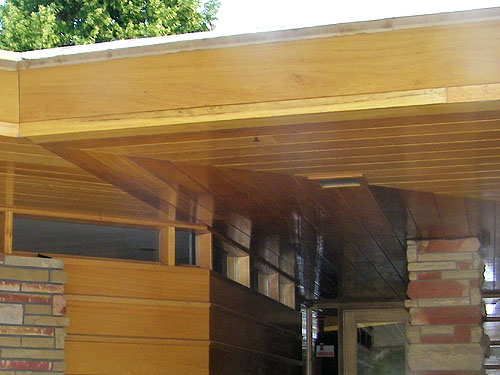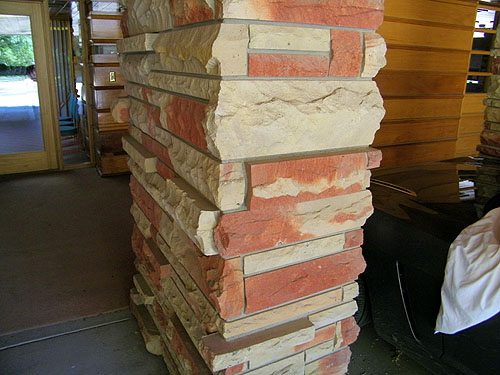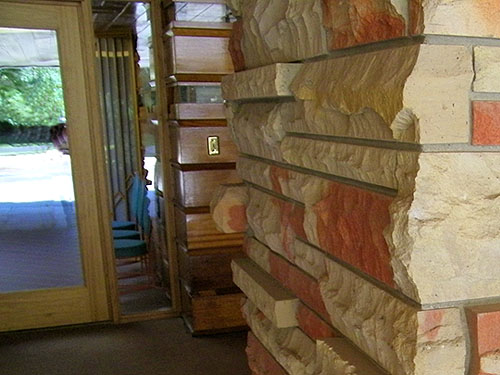|
|
|
|
|
WE
PROUDLY SUPPORT THE FRANK LLOYD WRIGHT BUILDING
CONSERVANCY
 |
|
|
|
|
|
WE
PROUDLY SUPPORT FALLINGWATER
AND THE WESTERN
PENNSYLVANIA CONSERVANCY
 |
|
|
|
|
QUINTIN & RUTH BLAIR
RESIDENCE, CODY, WYOMING (1952 - S.351) |
|
|
|
Introduction
Quintin & Ruth Blair
Blair Blueprints 1952
Floor Plans
Household Magazine June 1956
Fuller Brush 1962
NRHP 1989
Exterior Photographs 2009
Wright Designed Furniture
Blairs & Yellowstone Canyon Hotel
Yellowstone Canyon Hotel
Additional Wright Studies |
|
|
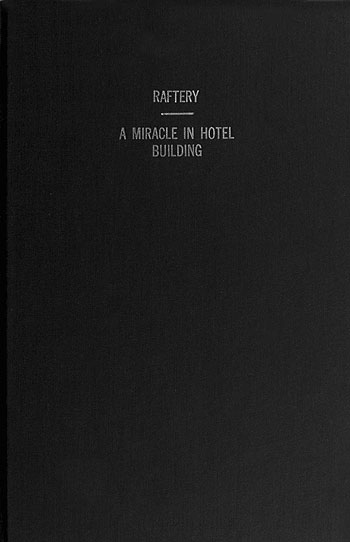 |
Date:
C 1911
Title: A Miracle in Hotel Building, Being the Story
of the Building of the New Canyon Hotel In Yellowstone Park (Published
by the Yellowstone Park Hotel Company)
Author: Raftery, John
Hentry; Photographs by F. J. Haynes
Description: Relates to the Quinton Blair Residence
(S.351). "...The two regiments of men who spent the winter of 1910-11
building this marvelous mountain hotel have been practically isolated
from the world for months. They have worked always seven days of the
week ; they had no saloon or club or theater to beguile their time or
bemuse their faculties, and even for the younger, pleasure-loving
workers there was no diversion, except the fierce thrill of gliding and
coasting on skis over the glacier-like slopes of the desolate
amphitheatre which surrounded them. There is probably no other like
example of hotel-building in history, and the structure which is the
result, the scene which it civilizes without desecrating, the strange
region which it adorns without vulgarizing are all in keeping and in
singular symmetry. ...Rustic it is not, in the sense that Old Faithful
Inn is rustic. Architect Robert C. Reamer, who also contrived and
constructed the historic Old Faithful Inn, smiled gravely when I
commented upon this impressive feature of his latest and greatest work,
saying: "I built it in keeping with the place where it stands. Nobody
could improve upon that. To be at discord with the landscape, would be
almost a crime. To try to improve upon it, would be an impertinence."
Digital copy. 6 x 9.25. For additional details
on this book see "A Miracle in Hotel Building. Yellowstone Canyon
Hotel"
Size:
Pages: Pp 15
S#:
0104.06.0909 |
|
|
|
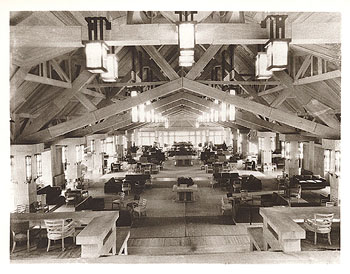 |
Date: 1940
Title:
Canyon Hotel Lounge, Yellowstone National Park (c) 37776.
Copyright by Haynes Inc., Yellowstone Park, Wyoming.
Description: Photographed by Frank J. Haynes.
Circa 1940. Original vintage photograph. (Relates to Blair
Residence)
Size:
4.75 x 3.75.
S#:
0531.25.0909 |
|
|
|
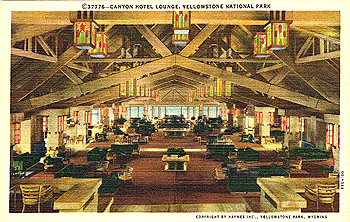 |
Date: 1940
Title:
Canyon Hotel Lounge, Yellowstone National Park (c) 37776.
Copyright by Haynes Inc., Yellowstone Park, Wyoming. OB-H369.
Description:
Back: Canyon Hotel Lounge, one of the show places of the park,
is the front wing of the hotel situated on the north side of the
Grand Canyon. Copyright by Haynes Inc., Yellowstone Park,
Wyoming, U.S.A. Genuine Curteich-Chicago "C.T. Art-Colortone"
Post Card (Reg. U.S. Pat. Off.) [Place one cent stamp here]
Size:
5.5 x 3.5.
ST#:
0531.24.0909 |
|
|
|
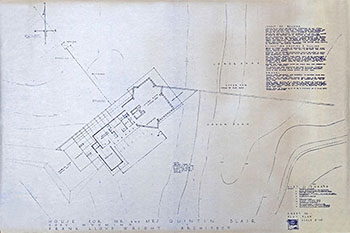 |
Date:
1952
Title:
Quintin & Ruth Blair Residence, Cody, Wyoming, Blueprint Sets
(2), Sheet 1 - 8A&B, 1952 (1952 - S.351).
Description:
Two original sets of nine Blueprints for
the Blair Residence. Designed by Frank Lloyd Wright in 1952. The
1,500 square foot house is laid out on a four foot grid system.
The house is dominated by a low flat roof that raises
dramatically over the living room which reaches fifteen feet
high on the Northeast side, and then cantilevers out eight feet,
much like the Alpaugh (1947 - S.293),
Shavin (1950 - S.339) and
Seth Peterson (1958 - S.430).
Designed in a rectangular shape, the...
Continue...
Size:
36 x 24
S#:
0910.76.0223. (1-9),
0910.77.0223. (1-9) |
|
|
|
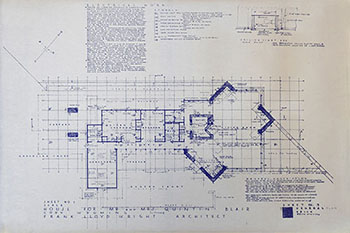 |
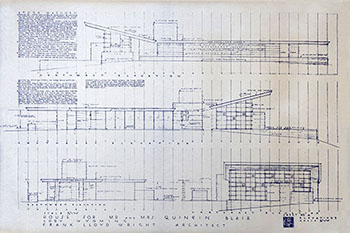
See additional details... |
|
|
|
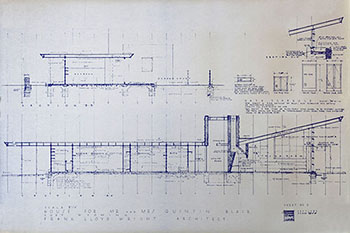 |
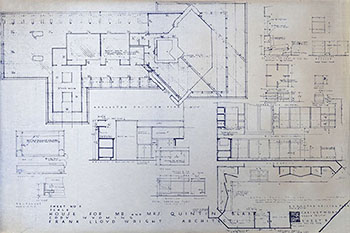
See additional details... |
|
|
|
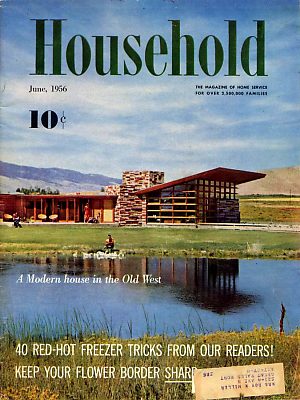 |
Date: 1956
Title:
Household - June 1956 ( Published by Capper Publications.
Topeka, Kansas.)
Author: Roland, Albert
Description:
A Modern house in the Old West. Blair House, Cody, Wyoming.
Photography by Warren Reynolds Photography, Inc. Includes 11
phoitographs of the Blair Residence.
(Sweeney 1122)
See
additional information...
Size:
8.5 x 11
Pages: Pp Cover, 4, 25-27,
70
S#: 1122.00.0802 |
|
|
|
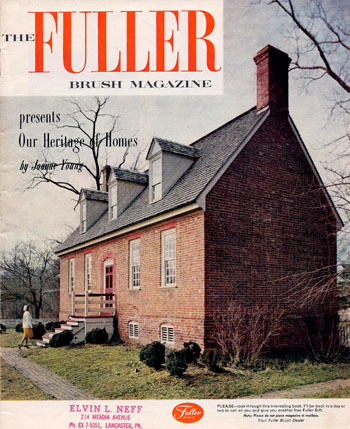 |
Date:
1962
Title: The Fuller Brush Magazine - 1962 (Published
by the Fuller Brush Company, Hartford, Conn.)
Author: Young, Joanne B.
Description: "Our Heritage of
Homes." The article is divided into a number of segments throughout the
magazine, each describing a different style of home. The back page is
devoted to the Quintin Blair Home (1952 - S.351). "When
Frank Lloyd Wright
first began designing his "Prairie houses"
eccentric was one of the milder terms used to describe his work. Even
today a
Frank Lloyd Wright
house such as the one above built for the
Quintin Blairs of Cody, Wyoming -- arouses so much interest that
homeowners find they're suddenly one of the sightseeing wonders of their
hometown!" Includes
one photograph by Warren Reynolds Photography, Inc.
taken in 1956.
Original cost: given as a sales tool. See
additional information...
Size:
8.25 x 10
Pages: P 24
S#: 1526.14.1011 |
|
|
|
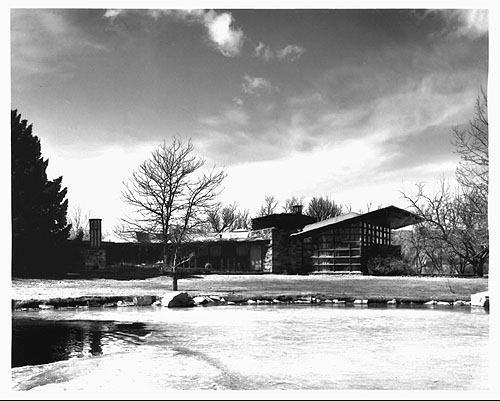 |
Date: 1989
Title:
The Blair Residence, National Register of Historic Places.
Description: The Blair Residence was placed
on the National Register of Historic Places in 1991. On
March 14, 1989 Richard Collier recorded these images for theNational Registry of Historic
Places. The Garage and Storage rooms
have been added, but the Master Bedroom has not.
See additional information...
Size:
Set of six photographs |
|
|
|
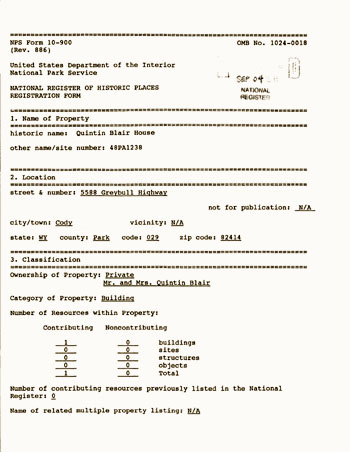 |
Date:
1991
Title: Quintin Blair House,
National Register of Historic Places (Published by the United States
Department of the Interior National Park Service, Washington, D.C.)
Author: Massey, Rheba;
Johnson, Mike
Description: The Quintin Blair house retains
excellent integrity of setting, materials, workmanship,
location, feeling, and association. The design represents the
major focus of Wright's architecture after World War II the
design of private homes that integrate with and reflect their
natural setting. The house is truly the work of a master
architect and worthy of listing on the National Register of
Historic Places for its exceptional significance. Includes four
illustrations.
Size:
8.5 x 11
Pages: Pp 17
ST#:
1991.48.0909 |
|
|
|
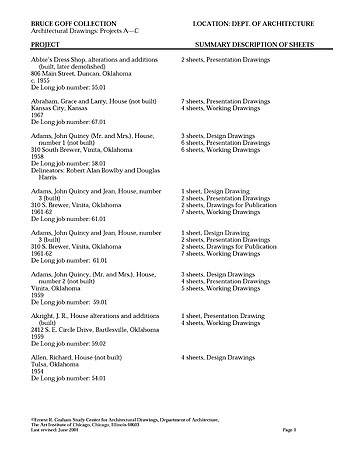 |
Date:
2001
Title: Bruce
Goff Collection, Architectural Drawings: Projects A-C (Compiled
and published by the Ernest R. Grahm Study Center for
Architectural Drawings, Department of Architecture, The Art
Institute of Chicago, Chicago, Illinois)
Author: Art
Institute of Chicago
Description: In 1990, The Art
Institute of Chicago received Goff's comprehensive archive
through the Shin'enKan Foundation, Inc. and Goff's executor, Joe
Price. Additional donations have been received from various
sources. Because of the vast scope of the archive, its contents
were subsequently divided according to material type between
several departments at the Art Institute. Holdings consist of
approximately 8,400 architectural and design drawings,
paintings, preliminary design sketches, presentation renderings,
and working drawings by Goff and various students and
apprentices. Includes revisions to the Blair Residence (S.351).
Size:
8.5 x 11
Pages: Pp 17
ST#:
2001.44.1009 |
|
|
|
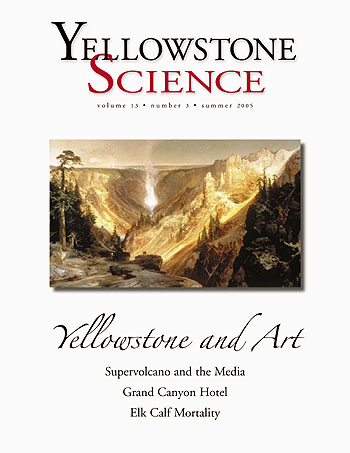 |
Date:
2005
Title: Yellowstone Science - Summer 2005 (Published
quarterly by the Yellowstone Center for Resources, Yellowstone National
Park, WY)
Author: Hert, Tamsen Emerson
Description:
"Luxury in the Wilderness. Yellowstone’s Grand Canyon Hotel,
1911-1960." History of the Hotel. Includes 35 photographs.
Relates to the Quinton Blair Residence (S.351). "...many
individuals recall visiting the park in 1959, stopping at the
hotel, and purchasing items laid out in the lounge. Quinn Blair
and his wife Ruth, of Cody, Wyoming, have Canyon Hotel light
fixtures adorning their Frank Lloyd Wright home (the only Wright
building in Wyoming), as does the Holiday Inn in Cody. The
Blairs also purchased a set of Limbert chairs from the president
of the YPC for $5 apiece at Mammoth Hot Springs." Digital Copy.
8
Size:
.5 x 11
Pages: Pp Inside Front
Cover, 21-36
ST#:
2005.23.0909 |
|
|
|
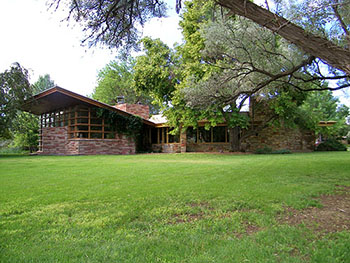 |
Date:
2009
Title:
Quintin and Ruth Blair Residence, Cody,
Wyoming (1952 - S.351).
Description: Set of 58
exterior photographs of the Blair Residence. There are many
classic Wright details in the two bedroom home. Three sides of
the Living and Dining Room are walls of glass, one and a half of
which are floor to ceiling. There are windows with mitered
corners. The Living Room roof cantilevers out eight feet. The
original carport had a roof that cantilevers out 12 feet. There
are built in shelves, seating and lighting. The centrally
located fireplace has a mantle that extends out at a 45 degree
angle. There are horizontal rows of floor to ceiling vertical
door and windows, double doors that open outward, clerestory
windows, cut-wood light screens. And a hidden entrance. Changes
and additions have taken place over the years. They hired Bruce
Goff, the architect that introduced Ruth to Wright...
Continue...
Size:
Set of 58 exterior color high res photographs.
ST#:
2009.61.0809 (1-58) |
|
|
|
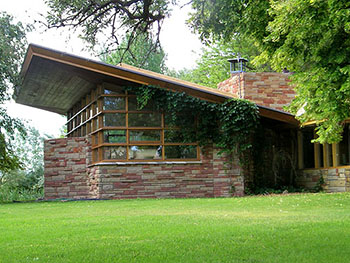 |
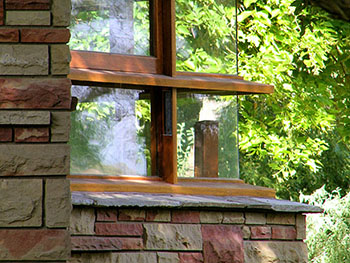 |
|
|
|
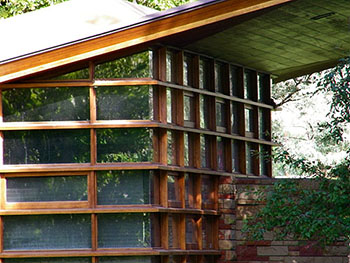 |
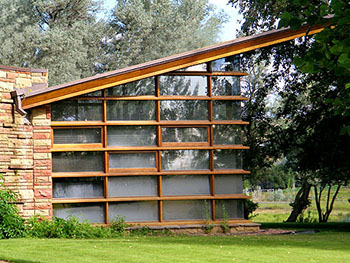 |
|
|
|
|
|
|
|
|
|
INTRODUCTION |
|
|
Over the past year and a half I
have had the opportunity to accompany my daughter on a
number of her business related road trips. She has been very
gracious to indulge me on these occasions, and we visited a
number of Wright properties. I happened to mention how much
fun it might be to take a road trip to Yellowstone and Mt.
Rushmore during the summer, and of course we could visit the
Blair Residence on the way. Much to my surprise, she picked
up on the idea and we made plans for August. With my wife,
daughter and her two kids, along with two car top carriers
we headed out. Our first evening camping in Yellowstone was
freezing, and I do not exaggerate. It warmed up nicely
during the day and was beautiful. On our second evening
camping in Yellowstone, hail started about six pm. Large
hail. In August. It covered the ground with about a half
inch of hail. Then the monsoons started. Someone mentioned
how nice a motel in Cody (our next stop) might be. It would
only take two hours, and the kids would love to swim, and we
would be warm. And they could swim the next morning while I
visited the Blair residence. We were on the road in ten
minutes at the most. The Blair's Holiday Inn was full, but
we did find a very nice motel for the evening.
As I drove up the driveway to the home the next
morning, two deer were grazing in the front yard. Quintin
Blair, now in his late 90's was unable to come to the door,
but his assistant was gracious enough to allow me to view
the outside of the home. Designed in 1952, it was completed
in 1954, and today is his only work in the state of Wyoming.
Ruth Taggart was a student at the Chicago Academy of Fine
Arts during the 1930s. One of her professors, Bruce Goff,
took the class to visit Taliesin at Spring Green, Wisconsin.
In 1951 Ruth and Quintin Blair were visiting Arizona. She
suggested that they visit Taliesin West in Arizona, where
Wright now lived and worked. Wright met them in the
driveway, lead them on a tour and invited them to stay for
lunch. At the luncheon, Wright offered to design a home for
them. In 1951 they purchased a 40 acre parcel of land in the
Big Horn Basin (NRHP) a few miles east
of Cody. Viewing the property today, with all its lush
vegetation, it is hard to image how barren and desolate it
looked at the time. Besides the wide open space, one of its
redeeming features was a stream that meandered through their
property which they dammed to create a pond. They began
planting a wide variety of trees, and today the home is barely
visible from the road.
The 1,500 square foot house is laid out on a four foot
grid designed. W. Kelly Oliver, drew the original plans. He
also was the
original supervising apprentice for the Dallas Theater
Center (S.395)and responsible for the completion after
Wright past away. The house is dominated by a low flat roof
that raises dramatically over the living room which reaches
fifteen feet high on the on the |
|
Northeast side, and then cantilevers out
eight feet, much like the Alpaugh (S.293), Shavin
(S.339) and Seth Peterson (S.430). Designed in a rectangular
shape, the workspace forms the lower leg of a short "L". The
Living Room, piano alcove and Workspace masonry is set at a 45 degree angle
to the rest of the home. The Northeast corner that projects
from the glass wall was designed as a piano niche. Wright
specified warm Philippine mahogany and locally-quarried red
and gold ashlar sandstone.
There are many classic Wright
details in the two bedroom home. Three sides of the Living and Dining Room are walls
of glass, one and a half of which are floor to ceiling.
There are windows with mitered corners. The Living Room roof
cantilevers out eight feet. The original carport
had a roof that cantilevers out 12 feet. There are built in shelves, seating and
lighting. The centrally located fireplace has a mantle that
extends out at a 45 degree angle. There are horizontal rows of
floor to ceiling vertical door and windows, double doors
that open outward, clerestory windows, cut-wood light
screens. And a hidden entrance.
The Blairs collected prairie styled
art glass light fixtures and dining room chairs
from the demolished
Yellowstone Canyon Hotel. One of the double stained
glass light fixtures is mounted on a stone pedestal in the
front yard and the second is on a pedestal in the Garden
Court. A smaller set of single stained glass wall mounted
light fixtures are mounted on either side of the entrance to
the Blair's Holiday Inn in Cody Wyoming. The Wright designed
dining room chairs were replaced with prairie styled chairs
they acquired from the
Yellowstone Canyon Hotel.
Changes and additions have taken place over the years.
They hired Bruce Goff, the architect that introduced Ruth to
Wright, to enclose the terrace and create a dining room,
enlarge the kitchen, and add a two car garage. According to
Randolph C. Henning, the Blair residence (to the best of his
recollection), is the only time the architectural genius of
both Wright & Bruce Goff physically came together in an
architectural work. He also mentioned that Michael Kreps was
the Bruce Goff apprentice who was responsible for the
drawings for the 1981 additions. After Bruce passed away,
Charles Montooth was hired to design a master bedroom.
While Ruth was probably the impetus for selecting
Wright, Quintin was just as involved in the process. Like
many of Wright's clients, he supervised the construction
himself. The Blair Residence was placed on the National
Register of Historic Places in 1991. .
"Our living room is beautiful...
you feel like a party in that big room... you always feel
like you want to dress up. There's a magic about it."
Ruth Blair. (Homearama)
Text by
Douglas M. Steiner, Copyright August 2009.
|
| |
|
|
|
|
|
|
|
|
|
|
QUINTIN & RUTH BLAIR |
|
|
|
Ruth
Taggart was a student at the Chicago Academy of Fine Arts
during the 1930s. One of her professors, Bruce Goff, took
the class to visit Taliesin at Spring Green, Wisconsin. In
1951 Ruth and Quintin Blair were visiting Arizona. She
suggested that they visit Taliesin West in Arizona, where
Wright now lived and worked. Wright met them in the
driveway, lead them on a tour and invited them to stay for
lunch. At the luncheon, Wright offered to design a home for
them. In 1951 they purchased a 40 acre parcel of land in the
Big Horn Basin (NRHP) a few miles east
of Cody. Viewing the property today, with all its lush
vegetation, it is hard to image how barren and desolate it
looked at the time. Besides the wide open space, one of its
redeeming features was a stream that meandered through their
property which they dammed to create a pond. They began
planting a wide variety of trees, and today the home
is barely visible from the road. |
|
The Blairs collected prairie styled
art glass light fixtures and dining room chairs
from the demolished
Yellowstone Canyon Hotel.
One of the double stained glass light fixtures is mounted on
a stone pedestal in the front yard and the second is on a
pedestal in the Garden Court.
Changes and additions have
taken place over the years. They hired Bruce Goff, the
architect that introduced Ruth to Wright, to enclose the
terrace and create a dining room, enlarge the kitchen, and
add a two car garage.
While Ruth was probably the impetus for selecting
Wright, Quintin was just as involved in the process. Like
many of Wright's clients, he supervised the construction
himself. The Blair Residence was placed on the National
Register of Historic Places in 1991. |
|
|
|
|
|
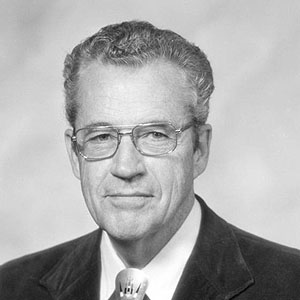 |
|
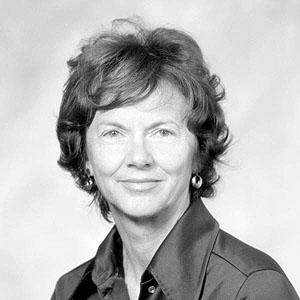 |
|
Photographed on August
23,1974. Courtesy Buffalo Bill Historical Center.
Photographer Jack Richard. |
|
|
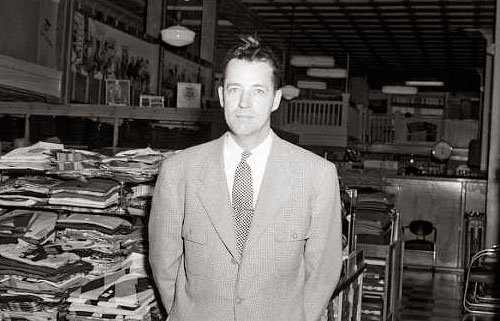 |
|
Quinn Blair 1952. Quinn Blair standing in front
of shelves in Cody Trading Company. Photographed in 1952 by
Jack Richard. Courtesy Buffalo Bill Historical Center. |
|
|
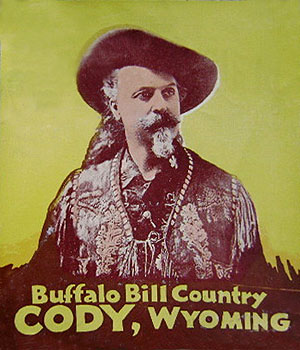
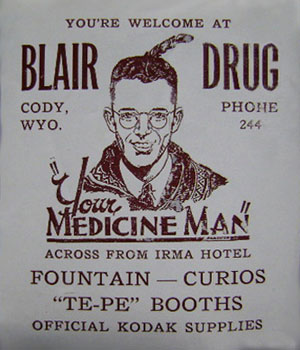 |
|
Advertising Card: Front |
|
Advertising Card: Back |
|
Quinn Blair had his pharmacy
license and owned Blair's Drugs. |
|
|
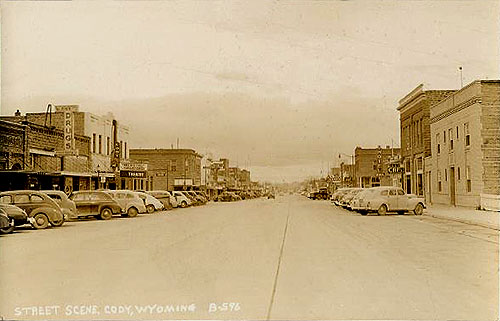 |
|
Postcard circa 1950.
"Street Scene, Cody, Wyoming." Blair's Drugs and Cody
Theater on the left, Irma Hotel on the right. |
|
|
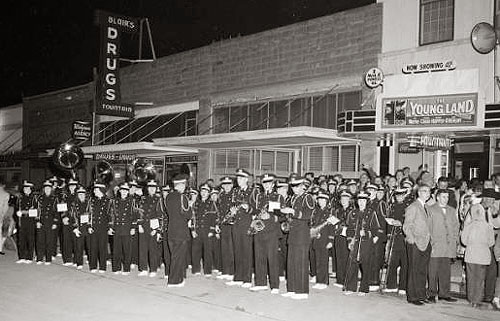 |
|
Blair's Drugs 1959. Cody High School band and
others standing in front of Blair's Drugs and Cody Theatre
in Cody, Wyoming for the opening of film "Young Land".
Patrick Wayne, the son of John Wayne, stared in dozens of
movies and television episodes. He stared with Dennis Hopper
in the film "Young Land" (1959), and had the lead roll as
Sheriff Jim Ellison. The opening of the film "Young Land"
in Cody coincided with the opening of the Whitney Gallery of
Western Art, April 23-24, 1959. Photographed by Jack Richard. Courtesy Buffalo
Bill Historical Center. |
|
|
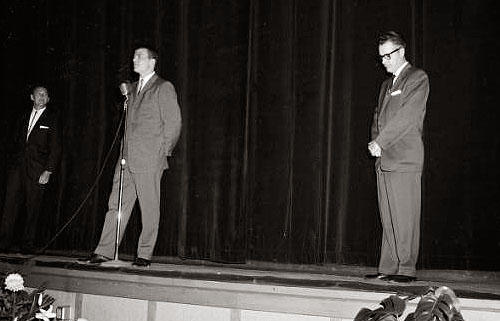 |
|
Quintin Blair 1959.
Patrick Wayne (center) with Quintin Blair (right) at Cody
Auditorium in Cody, Wyoming for the opening of the Whitney
Gallery of Western Art. Patrick Wayne, the son of John
Wayne, stared in dozens of movies and television episodes.
He stared with Dennis Hopper in the film "Young Land"
(1959), and had the lead roll as Sheriff Jim Ellison. The
opening of the film "Young Land" in Cody coincided
with the opening of the Whitney Gallery of Western Art, April
23-24, 1959. Photographed by Jack Richard. Courtesy Buffalo
Bill Historical Center. |
|
|
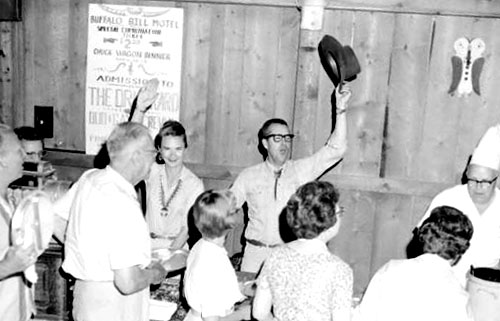 |
|
Ruth and Quinn Blair 1963.
Ruth and Quinn Blair waving while serving their Chuckwagon
Dinner at the Buffalo Bill Motel. August 16, 1963.
Photographed in 1963 by
Jack Richard. Courtesy Buffalo Bill Historical Center. |
|
|
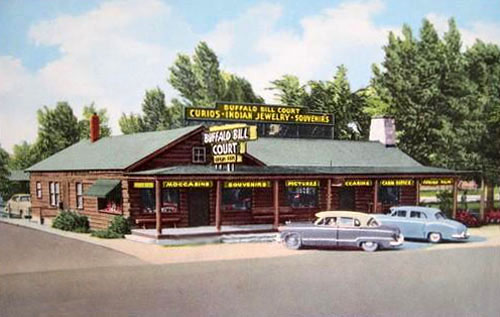 |
|
Postcard circa 1950's.
Buffalo Bill Court, Cody, Wyoming. Curios, Indian Jewelry,
Souvenirs. |
|
|
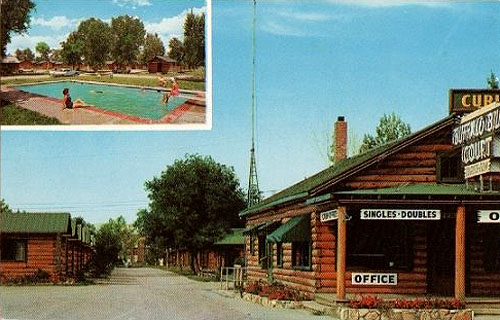 |
|
Postcard circa 1950's.
Buffalo Bill Court, Cody, Wyoming. Curios, Indian Jewelry,
Souvenirs. |
|
|
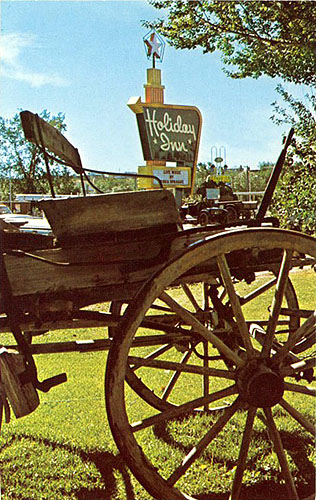 |
|
Postcard circa 1972's.
Holiday Inn, Cody, Wyoming. |
|
|
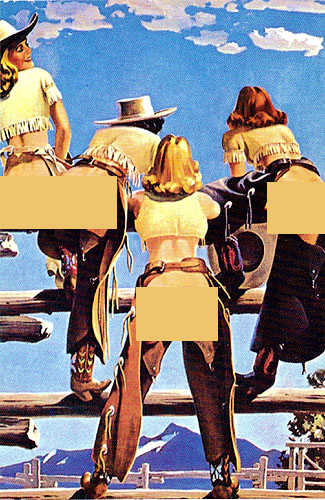 |
|
"Bottoms Up"
by
Edward T.
Grigware. According to the tale told by the front desk
at the Holiday Inn, Cody Wyoming. Edward T. Grigware was
a well-known artist, most notably in Cody, Wyoming for
his historic Cody murals. An acquaintance of Quintin
Blair commissioned Grigware to produce a painting of his
mistress. All four women in the painting are the same
woman. Upon his death, his wife wanted it out of her
home. Immediately. Quintin found out, paid $1 for it and hung
it in the Teepee Tap Room
of the original Buffalo Bill Village resort.
In 1972 with the opening of the Holiday Inn, the painting
was moved to its present location
"The Bottoms Up Lounge".
Stop in, view the lounge and ask for a free postcard. |
|
|
|
|
|
"Architecture" By Bruce Goff |
|
In 1978 Quintin and Ruth Blair were
involved in publishing a book on Bruce Goff. It was
published on the occasion of an exhibition of the art and
architecture of Bruce Goff for presentation at the
Yellowstone Art Center, Billings, Montana, May 5 - |
|
June 11, 1978. Soft Cover.
Published and manufactured by Quintin and Ruth Blair, F.
Wayne and Pat Gustafson, Delton and Janet Ludwig for the
Yellowstone Art Center, Billings, Montana. |
|
|
|
|
|
Ruth Blair, September 19, 1917 - August 21, 2007 |
Cody Enterprise
Published online on Wednesday, November 14, 2007Ruth
Taggart Blair
Ruth Taggart Blair, 89, died
Aug. 21, 2007, at West Park Hospital following injuries
sustained in an auto accident the previous Saturday.
She was born Sept. 19, 1917,
to Lloyd and Louise Taggart in Cowley, the first of nine
children. She married Quin Blair on Sept. 15, 1946.
Ruth was a longtime Cody
resident. She was a graduate of the Chicago Art Institute
with a varied career as lead designer for Thomas Molesworth,
an interior decorator, co-proprietor of the Buffalo Bill
Village and eventually Quin Blair Enterprises.
Ruth, together with her
husband, was an icon in the endeavor of Western hospitality
in Wyoming. She was instrumental in the development of the
Western Design Conference in Cody. Prior to 1999 she was an
active member of the Frank Lloyd Wright Foundation.
She was an active and
lifelong member of the Church of Jesus Christ of Latter-day
Saints.
She is survived by her
husband of 61 years, her son Frederick "Ted" (Judie) Blair,
grandsons James (Emily) Blair, Quintin Blair and Taggart
Blair, great-grandson Taylor Blair, her brother Scott
Taggart, sisters Mary Louise Greever, Harriet Burtus, Becky
Watkins and Ray Rita Keif, and numerous nieces, nephews,
cousins and friends.
She was preceded in death by
brothers Jesse "Mac" Taggart, Lloyd Taggart and Charles
Taggart.
Funeral services were Aug. 24
at the Church of Jesus Christ of Latter-day Saints Stake
Center. Interment followed in Riverside Cemetery. |
|
|
|
|
|
|
|
|
|
|
BLAIR RESIDENCE BLUEPRINTS (1952) |
|
|
|
| Quintin & Ruth Blair
Residence, Cody, Wyoming, Blueprint Sets (2), Sheet 1-8A&B, 1952
(1952 - S.351). Two original sets of nine Blueprints for the
Blair Residence. Designed by Frank Lloyd Wright in 1952. The
1,500 square foot house is laid out on a four foot grid
system. The house is dominated by a low flat roof that
raises dramatically over the living room which reaches
fifteen feet high on the Northeast side, and then
cantilevers out eight feet, much like
the Alpaugh
(1947 - S.293), Shavin (1950 -
S.339) and Seth Peterson (1958 -
S.430). Designed in a rectangular shape, the
workspace forms the lower leg of a short "L". The Living
Room, piano alcove and Workspace masonry is set at a 45
degree angle to the rest of the home. The Northeast corner
that projects from the glass wall was as a piano niche.
Wright |
|
specified warm Philippine designed
mahogany and locally-quarried red and gold ashlar sandstone.
There are many classic Wright details in the two
bedroom home. Three sides of the Living and Dining Room are
walls of glass, one and a half of which are floor to
ceiling. There are windows with mitered corners. The Living
Room roof cantilevers out eight feet. The original carport
had a roof that cantilevers out 12 feet. There are built in
shelves, seating and lighting. The centrally located
fireplace has a mantle that extends out at a 45 degree
angle. There are horizontal rows of floor to ceiling
vertical door and windows, double doors that open outward,
clerestory windows, cut-wood light screens. And a hidden
entrance. |
|
|
|
|
|
SHEET 1 SHEET
2 SHEET 3
SHEET 4 SHEET
5 SHEET 6
SHEET 7 SHEET
8 SHEET 8 REV
|
|
|
|
|
SHEET 1 |
|
|
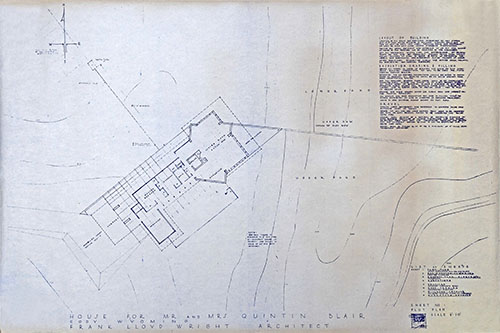 |
| 1) Plot Plan, Sheet 1. Left to right:
Carport (Open), Dark Room and Workshop, Master Bedroom, Bath
and Lavatory, Workspace, Utility and Living Room. Text top
right: “Layout of building... Excavation, Grading, and
Filling... Gravel...” Lower Text: “House for Mr. And Mrs.
Quintin Blair. Cody, Wyoming. Frank Lloyd Wright Architect.”
Text bottom right: “Sheet No. 1. Plot Plan.” Signed within
the square: “FLLW. July 20, 52.” 36 x 24. (S#0910.76 &
0910.77 -1) |
| |
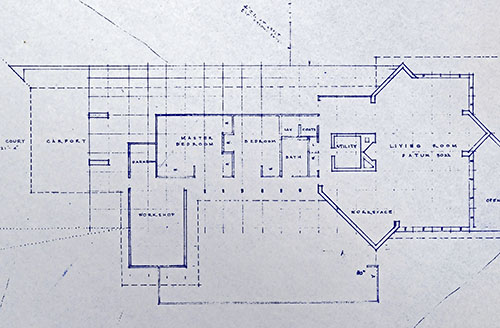 |
| 1A) Detail of the Plot Plan, Sheet 1. |
| |
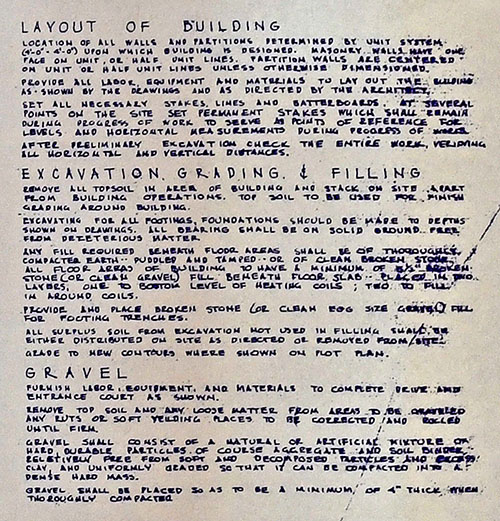 |
| 1B) Detail of the Plot Plan, Sheet 1.
|
| |
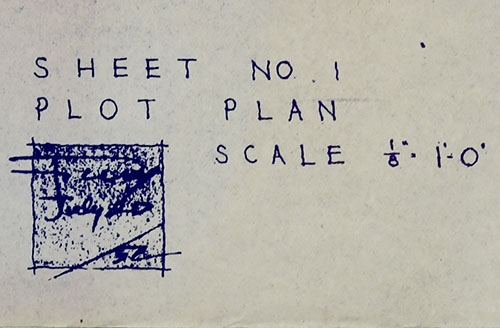 |
| 1C) Detail of the Plot Plan, Sheet 1.
|
| |
| |
|
SHEET 2 |
| |
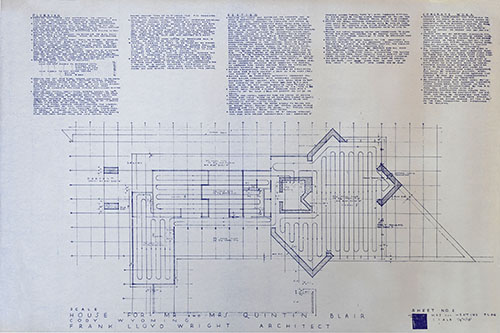 |
| 2) Material and Heating Plan, Sheet
2. Upper text: “Plumbing… Heating… Concrete Work…” Lower
Text: “House for Mr. And Mrs. Quintin Blair. Cody, Wyoming.
Frank Lloyd Wright Architect.” Text bottom right: “Sheet No.
2. Mat and Heating Plan.” Signed within the square: “FLLW.
July 20, 52.” 36 x 24. (S#0910.76 & 0910.77 -2) |
| |
| |
|
SHEET 3 |
| |
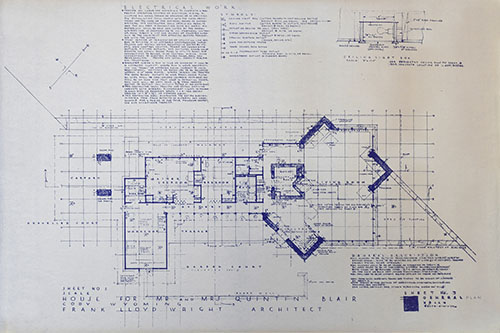 |
| 3) General Plan, Sheet 3. Left to
right: Carport (Open), Gravelled Court, Dark Room and
Workshop, Master Bedroom, Bath and Lavatory, Workspace,
Utility and Living Room. Upper text: “Electrical Work…
Symbols… Ceiling Light Box…” Lower Text: “House for Mr. And
Mrs. Quintin Blair. Cody, Wyoming. Frank Lloyd Wright
Architect.” Text lower right: “General Description…” Text
bottom right: “Sheet No. 3. General Plan.” Signed within the
square: “FLLW. July 20, 52.” 36 x 24. (S#0910.76 & 0910.77
-3) |
| |
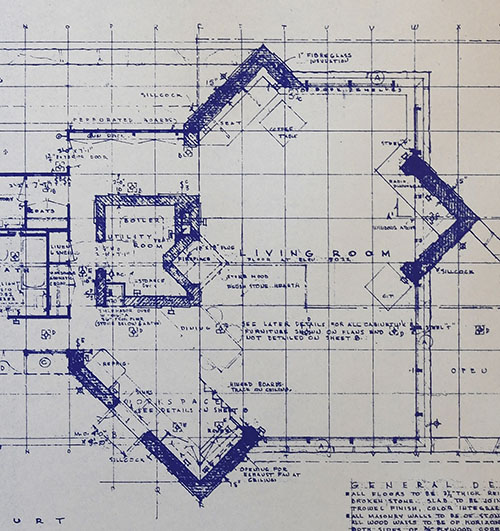 |
| 3B) Detail of the General Plan, Sheet
3. |
| |
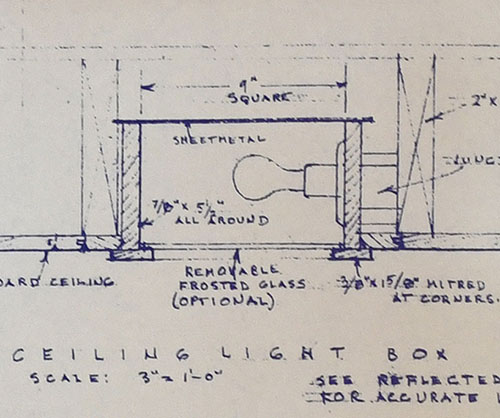 |
| 3C) Detail of the General Plan, Sheet
3. |
| |
| |
|
SHEET 4 |
| |
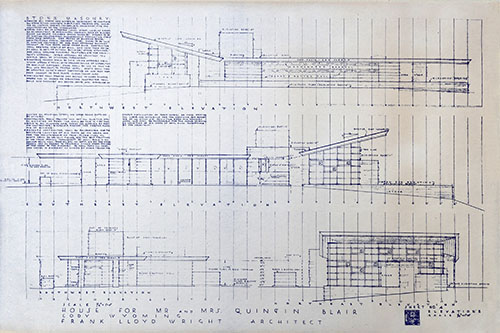 |
| 4) Elevations, Sheet 4. Top to
bottom: Northwest Elevation. Southeast Elevation. Southwest
Elevation. Northeast Elevation. Upper text: “Stone Masonry…
” Lower Text: “House for Mr. And Mrs. Quintin Blair. Cody,
Wyoming. Frank Lloyd Wright Architect.” Text bottom right:
“Sheet No. 4. Elevations.” Signed within the square: “FLLW.
July 20, 52.” 36 x 24. (S#0910.76 & 0910.77 -4) |
| |
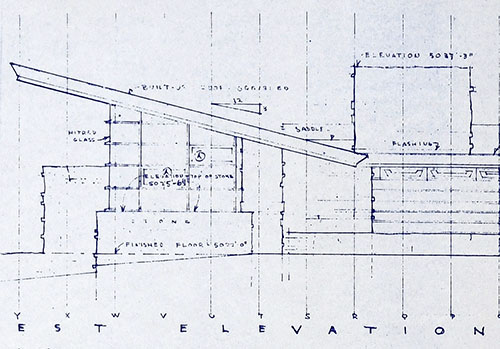 |
| 4B) Detail of the Elevations, Sheet
4. |
| |
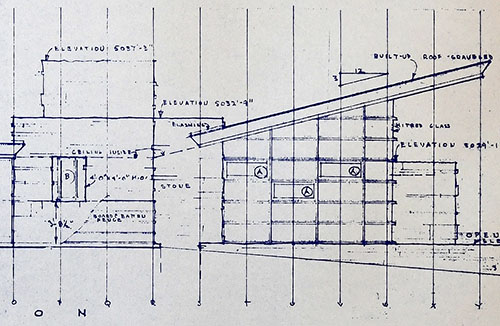 |
| 4C) Detail of the Elevations, Sheet
4. |
| |
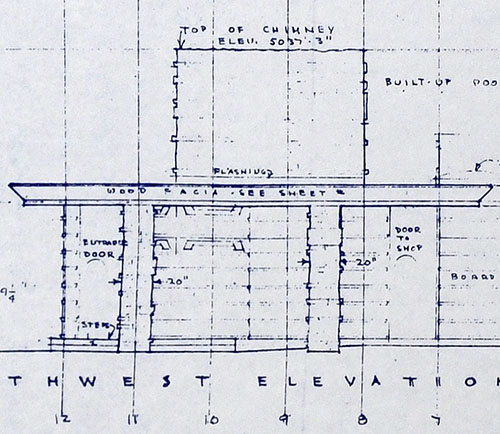 |
| 4D) Detail of the Elevations, Sheet
4. |
| |
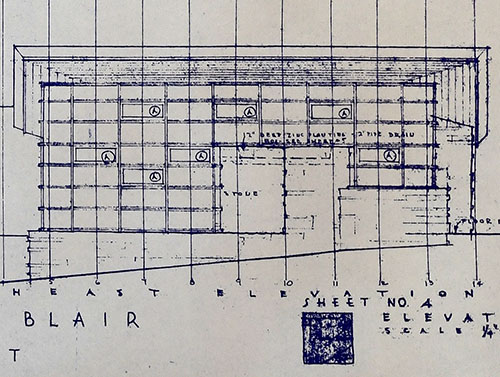 |
| 4E) Detail of the Elevations, Sheet
4. |
| |
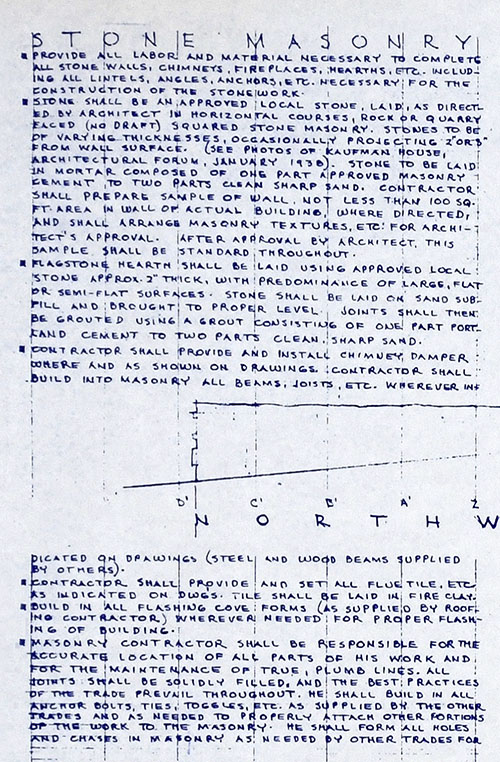 |
| 4F) Detail of the Elevations, Sheet
4. |
| |
| |
|
SHEET 5 |
| |
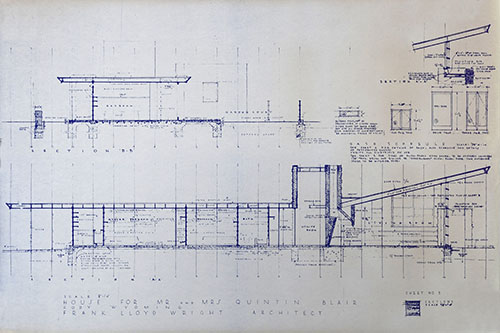 |
| 5) Sections, Sheet 5. Top to bottom:
Section B - B. Section A - A. Section A - A. Right text:
“Sash schedule…” Lower Text: “House for Mr. And Mrs. Quintin
Blair. Cody, Wyoming. Frank Lloyd Wright Architect.” Text
bottom right: “Sheet No. 5. Sections.” Signed within the
square: “FLLW. July 20, 52.” 36 x 24. (S#0910.76 & 0910.77
-5) |
| |
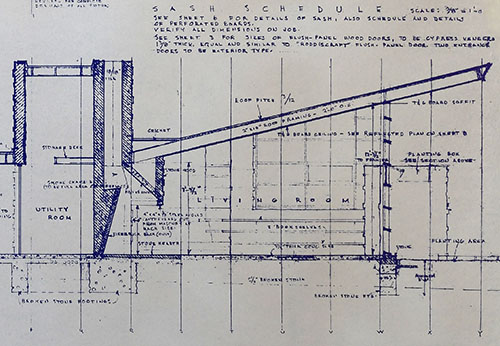 |
| 5B) Detail of the Sections, Sheet 5. |
| |
| |
|
SHEET 6 |
| |
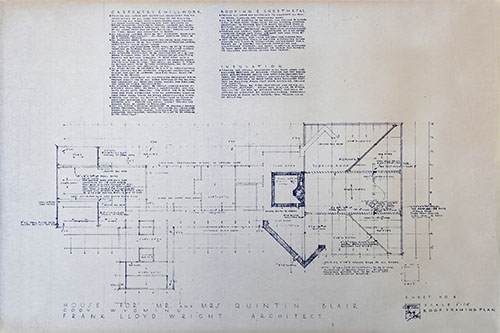 |
| 6) Roof Framing Plan, Sheet 6. Upper
text: “Carpentry and Millwork… Roofing and Sheet Metal…
Insulation…” Lower Text: “House for Mr. And Mrs. Quintin
Blair. Cody, Wyoming. Frank Lloyd Wright Architect.” Text
bottom right: “Sheet No. 6. Roof Framing Plan.” Signed
within the square: “FLLW. July 20, 52.” 36 x 24. (S#0910.76
& 0910.77 -6) |
| |
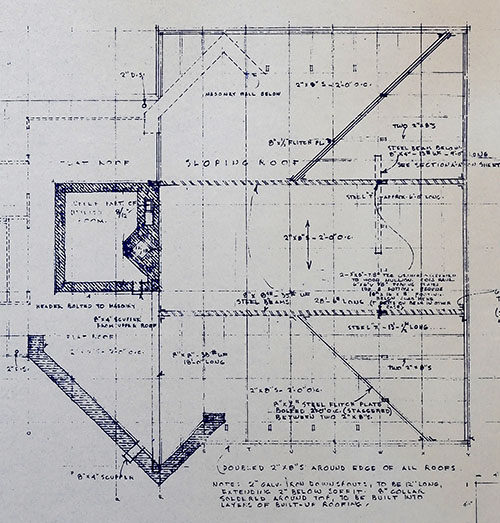 |
| 6B) Detail of the Roof Framing Plan,
Sheet 6. |
| |
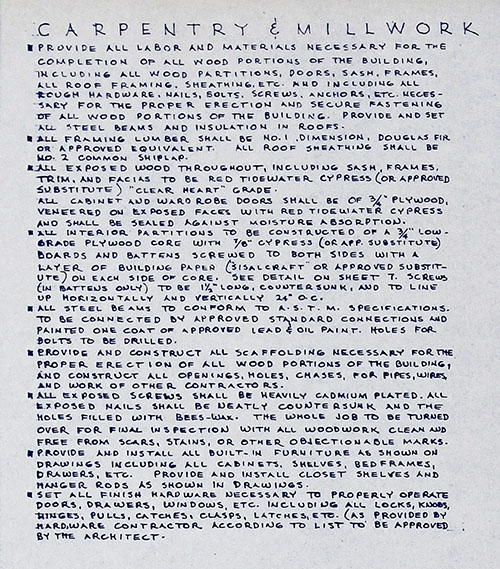 |
| 6c) Detail of the Roof Framing Plan,
Sheet 6. |
| |
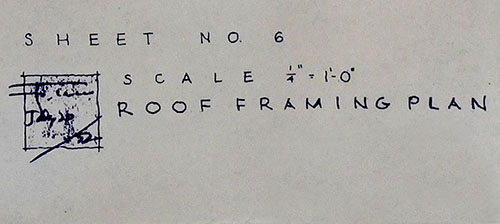 |
| 6C) Detail of the Roof Framing Plan,
Sheet 6. |
| |
| |
|
SHEET 7 |
| |
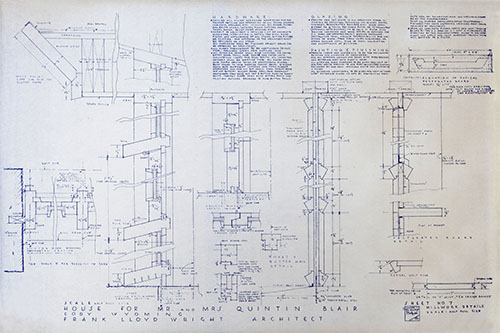 |
| 7) Millwork Details, Sheet 7. Upper
Text: Hardware… Glazing… Painting and Finishing… Elevation
of Typical Perforated Board.” Lower Text: “House for Mr. And
Mrs. Quintin Blair. Cody, Wyoming. Frank Lloyd Wright
Architect.” Text bottom right: “Sheet No. 7. Millwork
Details.” Signed within the square: “FLLW. July 20, 52.” 36
x 24. (S#0910.76 & 0910.77 -7) |
| |
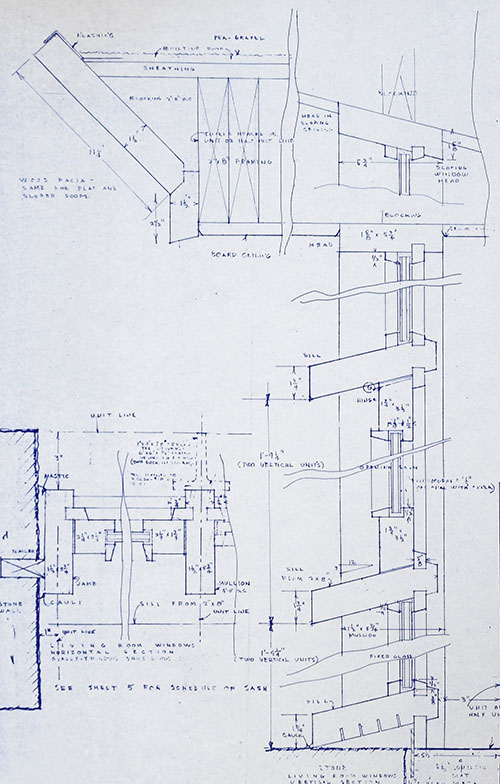 |
| 7A) Details of the Millwork Details,
Sheet 7. |
| |
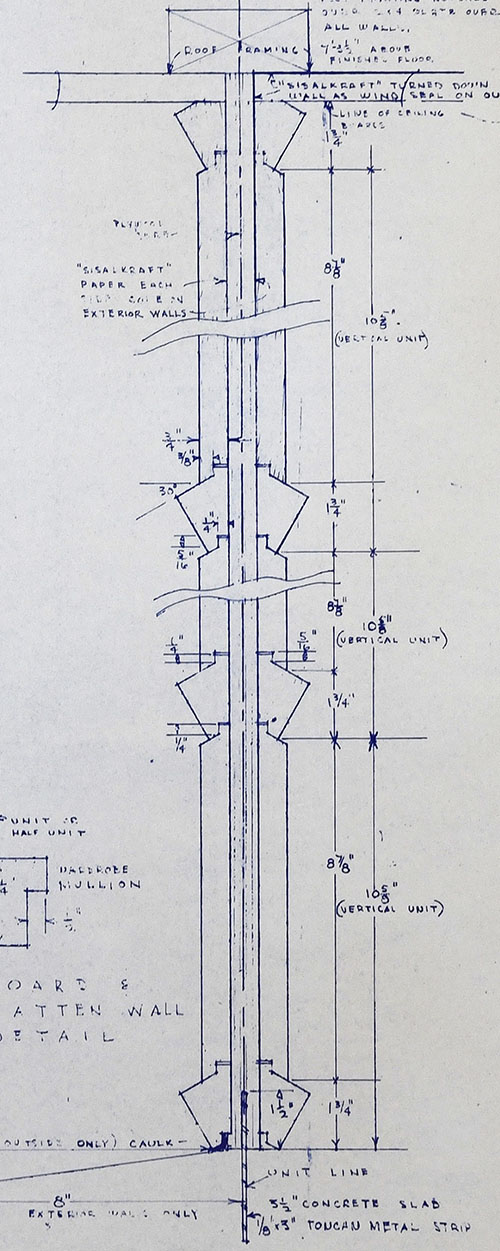 |
| 7B) Details of the Millwork Details,
Sheet 7. |
| |
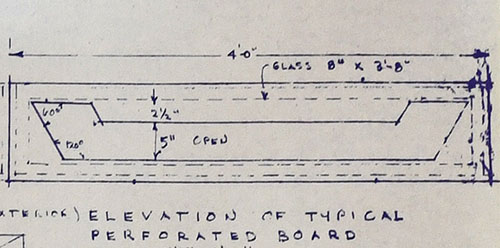 |
| 7C) Details of the Millwork Details,
Sheet 7. |
| |
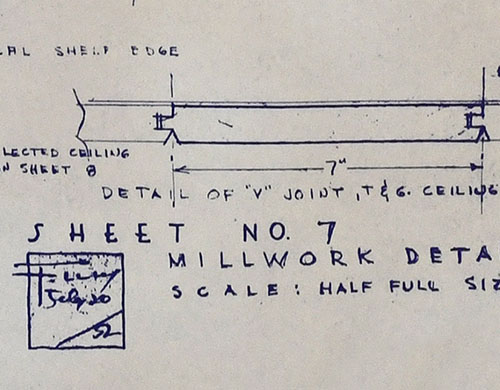 |
| 7D) Details of the Millwork Details,
Sheet 7. |
| |
| |
|
SHEET 8 |
| |
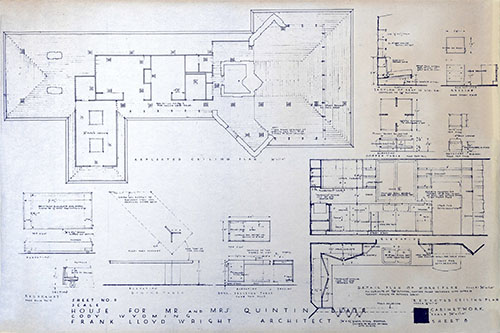 |
| 8) Reflected Ceiling Plan, Cabinet
Work, Sheet 8. Top to bottom: Reflected Ceiling Plan.
Section of Seat in Living Room. Bedside. Coffee Table.
Hassocks. Bed Frames. Dining Table. Desk - Dressing Table.
Detail Plan of Workspace. Lower Text: “House for Mr. And
Mrs. Quintin Blair. Cody, Wyoming. Frank Lloyd Wright
Architect.” Text bottom right: “Sheet No. 8. Reflected
Ceiling Plan, Cabinet Work.” Signed within the square:
“FLLW. July 20, 52.” 36 x 24. (S#0910.76 & 0910.77 -8) |
| |
|
8A) Detail of the Reflected Ceiling Plan, Cabinet Work, |
| |
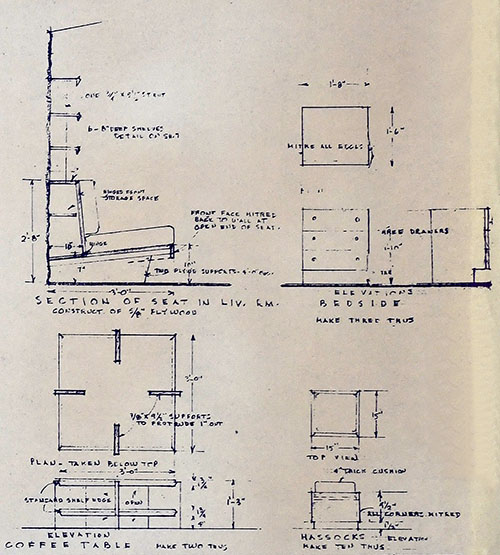 |
| 8B) Detail of the Reflected Ceiling
Plan, Cabinet Work, |
| |
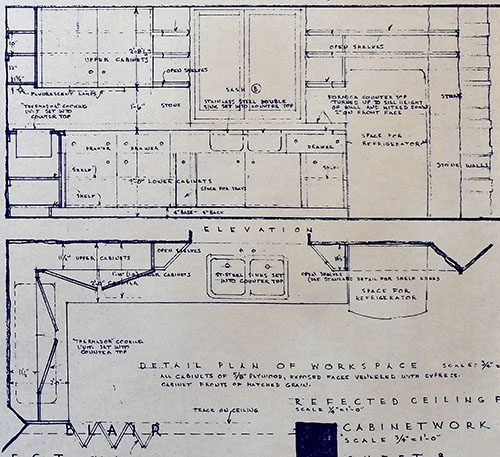 |
| 8C) Detail of the Reflected Ceiling
Plan, Cabinet Work, |
| |
| |
|
SHEET 8 REV |
| |
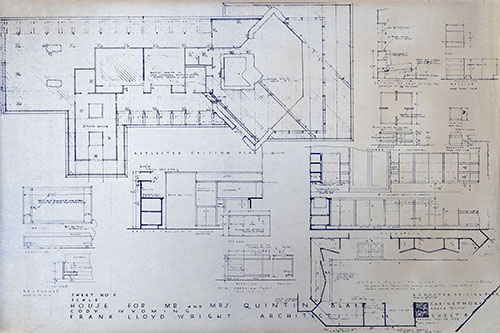 |
| 9) Reflected Ceiling Plan, Cabinet
Work, Sheet 8 (Revised Feb 25, 1953). Top to bottom:
Reflected Ceiling Plan. Section of Seat in Living Room.
Bedside. Coffee Table. Hassocks. Bed Frames. Elevation of
Workspace. Desk - Dressing Table. Detail Plan of Workspace.
Lower Text: “House for Mr. And Mrs. Quintin Blair. Cody,
Wyoming. Frank Lloyd Wright Architect.” Text bottom right:
“Sheet No. 8. Reflected Ceiling Plan, Cabinet Work. Revised
Feb 25, 1953” Signed within the square: “FLLW. July 20, 52.”
36 x 24. (S#0910.76 & 0910.77 -9) |
| |
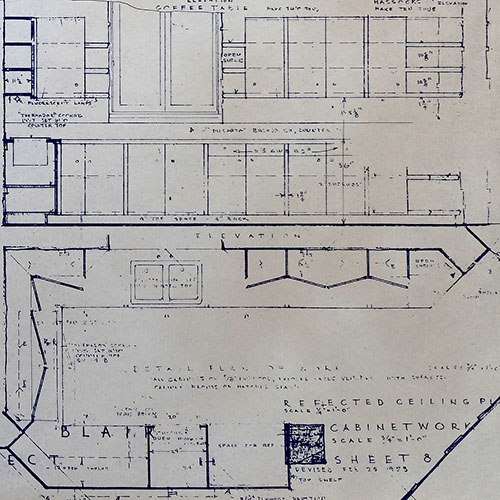 |
| 9B) Detail of the Reflected Ceiling
Plan, Cabinet Work, Sheet 8 (Revised Feb 25, 1953). |
| |
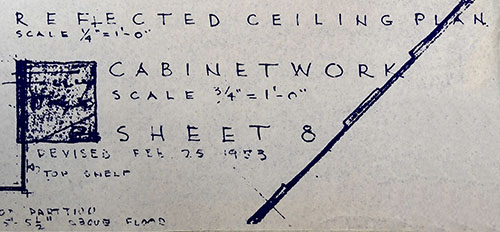 |
| 9C) Detail of the Reflected Ceiling
Plan, Cabinet Work, Sheet 8 (Revised Feb 25, 1953). |
|
|
|
|
|
|
|
|
|
|
|
FLOOR PLAN |
|
|
|
|
Original Floor Plan 1954
Revised Floor Plan 1956
Goff Floor Plan 1981
Floor Plan 1991 |
|
|
|
|
Original Floor Plan 1954 |
|
|
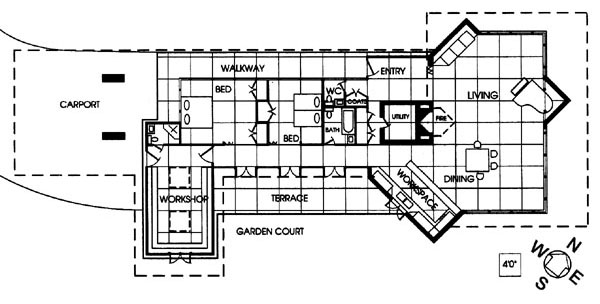 |
|
Floor plan copyright 1993, The
Frank Lloyd Wright Companion, Storrer, William Allin, page
372-373. |
|
|
|
|
|
|
|
Revised Floor Plan 1956 |
|
|
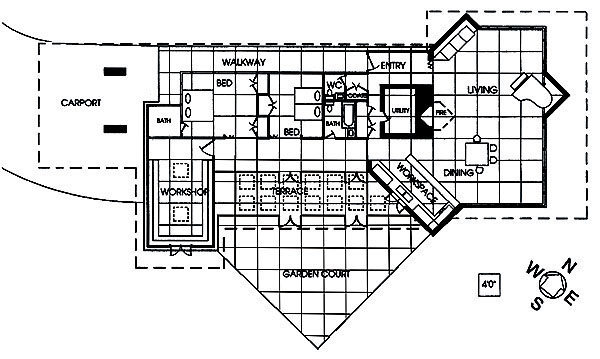 |
|
After further research and
additional documentation as well as published photographs in
the June 1956 issue of Household Magazine, the Originl
Floor Plan was modified by Douglas M. Steiner, copyright
2009. |
|
|
|
|
|
|
|
|
Floor Plan After Bruce Goff Addition 1981 |
|
|
Changes and additions have been
fluid over the years.
In 1981 they hired Bruce Goff, the architect that introduced Ruth to
Wright, to design a Master Bedroom, add a two car Garage,
enlarge the kitchen, create a formal dining room,
and create a Library in place of the old Workspace.
According to Randolph C. Henning, the Blair residence (to
the best of his recollection), is the only time the
architectural genius of both Wright & Bruce Goff physically
came together in an architectural work. He also mentioned
that Grant Gustafson and Michael Kreps were
the Bruce Goff apprentices who were responsible for the
drawings for the 1981 additions.
Two sets of plans exist
for the 1981 alterations. The first set, which
includes ten pages and is undated, lists
Bruce Goff as Architect and J. Palmer Boggs as Structural
Engineer. This set indicates that the kitchen has been moved from the "Workspace" to the
original "Workshop" area. Bruce designed a
two story addition touching the Northern corner of the
Living Room, and a Garage and Storage areas off the Southern
end of the home. The plans also included a number of
built-in planters to be added around the exterior of the home as well
as a pool by the entry. The two story addition includes a
Hobby Room, Plant Room and full Bath on the main floor. The
second floor includes a Master Bedroom, full Bath and two
Decks. The addition on the Southern end of the home
includes a two car Garage, and three Storage areas.
The second set of plans
is dated Nov. 4, 1981 and includes 17 pages. It lists
Bruce Goff as Architect, R. Michael Kreps Architect -
Drawing, and J. Palmer Boggs as Structural
Engineer. This set indicates that the kitchen has been
moved from the "Workspace" to the original "Workshop"
area. |
|
Bruce designed a
two story addition touching the Northern corner of the Living Room and
a Garage and Storage areas off the Southern end of the home.
The plans also included a number of built-in planters to be
added around the exterior of the home, a pool by the entry
and a second in the back yard attached to the terrace. Bruce
also designed a pedestal for the Yellowstone Canyon Hotel
light fixtures. The two story addition which is larger than
the first design, includes a Living Room, Studio, Utility,
Bath and Aqua/Arium on the main floor. The second floor
includes a Master Bedroom, full Bath and two Decks. The
addition on the Southern end of the home includes a two car
Garage, and three Storage areas. Additional changes to the
original structure include expanding the Eastern corner of
the new Kitchen (Old Workshop) and adding windows and a
planter. It also includes removing the original Workspace on
the Southern end of the Living Room, opening up the area to
create a Library. These plans also indicate that all the
interior doors and window partitions between the Terrace and
the Bedrooms have been removed except a panel on each end,
and suggest removing these, completely opening up the area
for formal Dining Room.
The additions which
were completed from these two designs included the Garage
and Storage areas on the Southern end, expanding the Eastern
corner of the new Kitchen (Old Workshop), adding windows and
a planter, removing the original Workspace on the Southern
end of the Living Room, opening up the area to create a
Library and completely opening up and creating a formal
Dining Room.
After Bruce passed
away, Charles Montooth was hired to design and complete a master bedroom. |
|
|
|
|
|
|
|
|
|
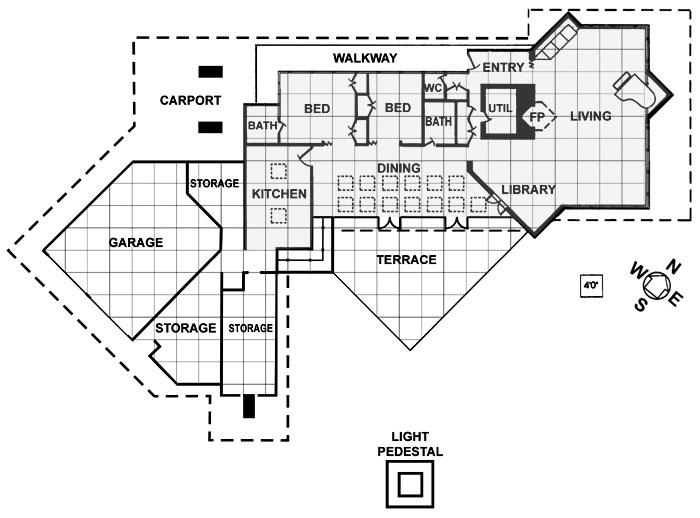 |
|
Floor plan after the Bruce Goff
Addition. Drawn by Douglas M.
Steiner. Gray tone indicated original
structure. Copyright 2009. |
|
|
|
|
|
|
|
|
Floor Plan
1991 |
|
|
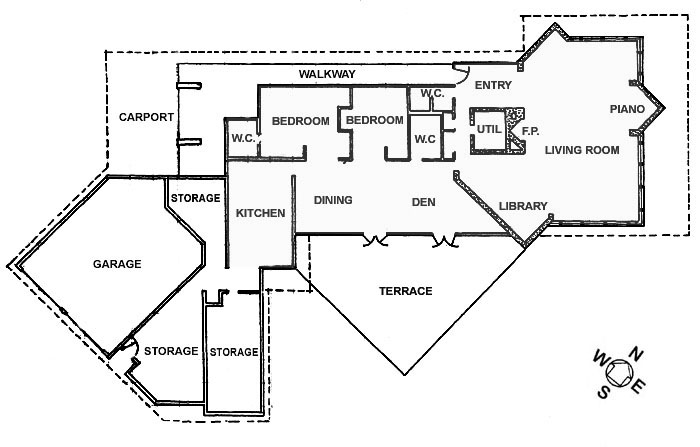 |
|
Floor plan copyright 1991,
National Registry of Historic Places. Modified by Douglas M.
Steiner. Gray tone indicated original
structure. |
|
| |
|
|
|
|
|
|
|
|
HOUSEHOLD MAGAZINE, JUNE 1956 |
|
|
|
|
"Even if you're cold to Modern
architecture, we believe you'll warm up to the Quintin Blair
home near Cody, Wyoming... From any angle, it is part of the
landscape, as it it grew there." Household Magazine, June
1956, Cover and pages 25-27, 65, 70. Published by Capper Publications. Topeka, Kansas. Text by
Albert Roland. Photography by Warren Reynolds Photography, Inc. |
|
|
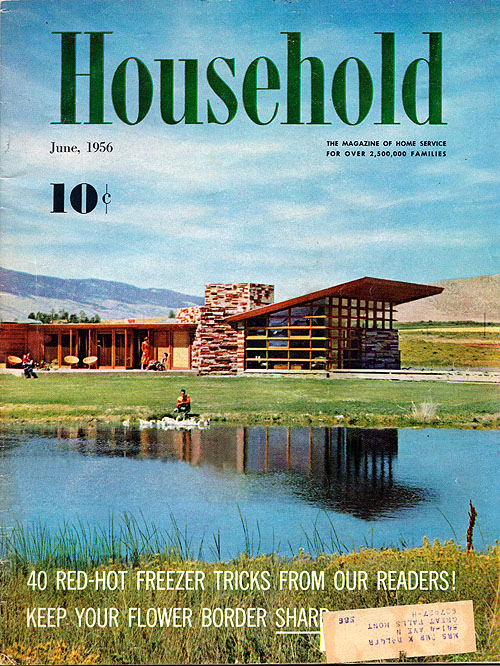 |
|
Household Magazine, June 1956,
Cover and pages 25-27, 65, 70. Published by Capper Publications. Topeka, Kansas. Text by
Albert Roland. Photography by Warren Reynolds Photography, Inc. |
|
|
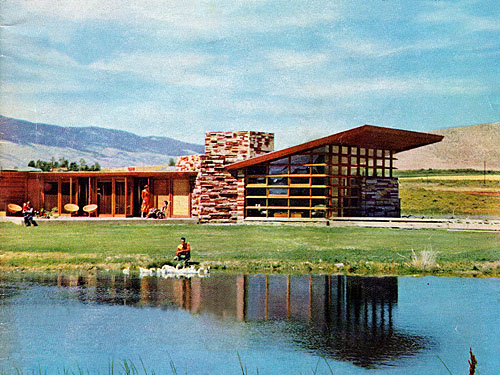 |
|
1) Image from cover. |
|
|
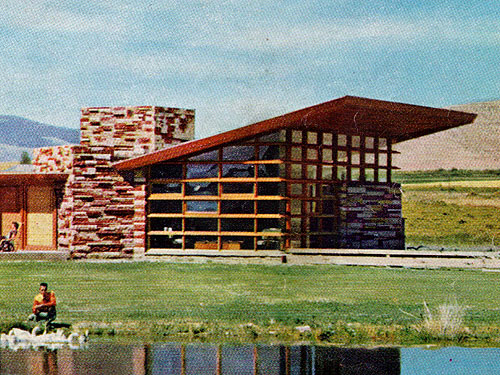 |
|
1B) Detail Image from cover. |
|
|
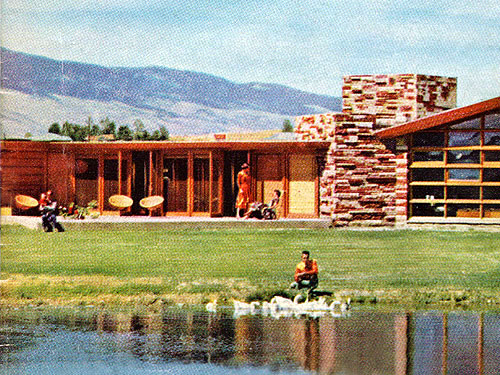 |
|
1C) Detail Image from cover. |
|
|
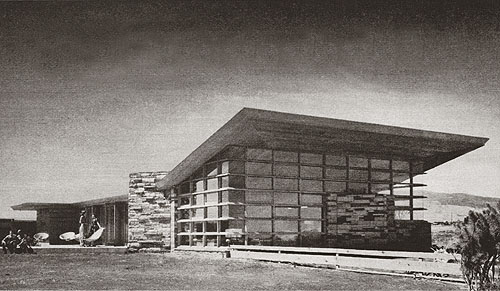 |
|
2) "A Modern house in the Old
West" page 25. |
|
|
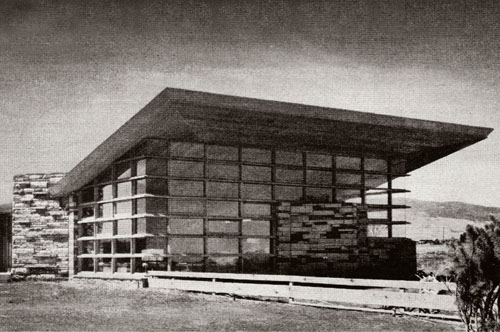 |
|
2B) Detail page 25. |
|
|
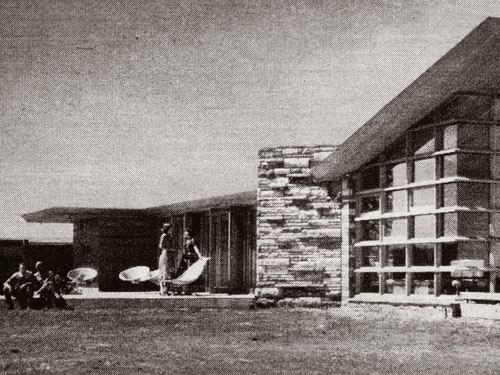 |
|
2C) Detail page 25. |
|
|
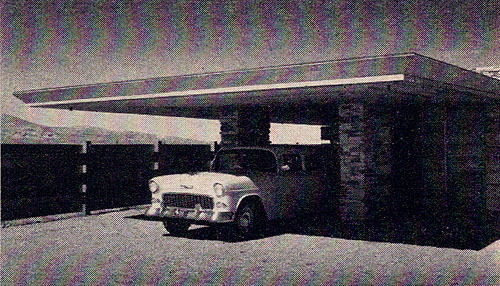 |
|
3) "Two massive sandstone
pillars support the wide tar-and-gravel roof that extends
over carport, stressing horizontal sweep of house.
Entry is around corner at left; door at right leads to
family work room." Page 25. |
|
|
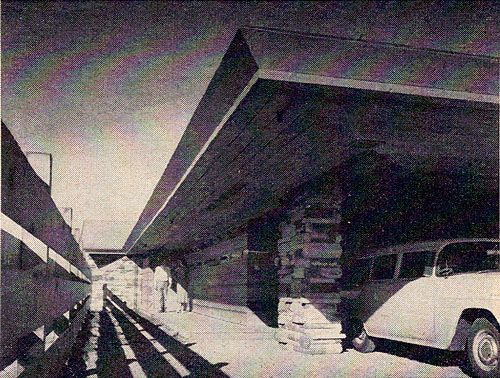 |
|
4) "The wide overhand provides a
covered walk from car to house, and it shields wall from the
west sun. Tall fence and small, high windows also cut down
summer afternoon heat - no exposed glass on the west!" Page
25. |
|
|
|
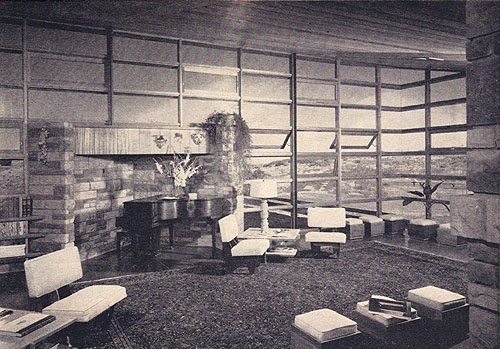 |
|
5) "As you step inside, a hall
to your right leads to the kitchen; straight ahead is the
entrance to the living room. The ceiling rises upward
toward the window walls, opening the room to the outdoors."
Page 26. (Note the original Wright designed furniture.) |
|
|
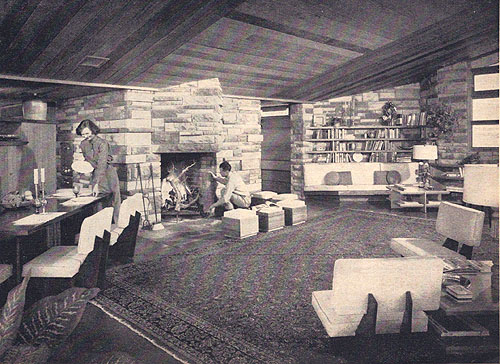 |
|
6) "But you get the fish-bowl
feeling, for the sandstone walls and massive fireplace give
you a solid sense of shelter. Triangular stone hood on the
fireplace echoes the design of the unusual piano niche on
the opposite wall. The pattern of the boards adds interest
to the ceiling, and extends through the walls to the wide
overhang, stressing the indoor-outdoor unity of design that
is basic in this house. At left is the dining area - you can
see the built-in oven of the kitchen in the background."
Page 26. (Note the original Wright designed
furniture.) |
| |
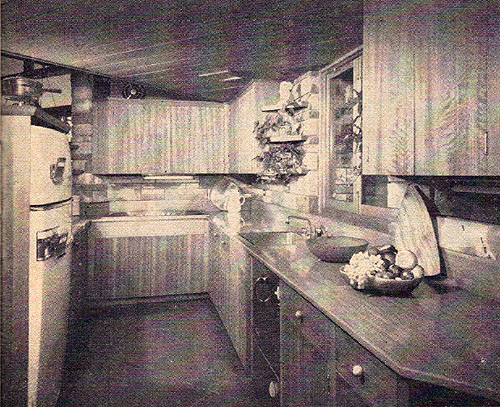 |
|
7) "Compact kitchen is
functionally open to the living-dining area, yet a divider
conceals the refrigerator (at left), and suggests
separation. Window over the sink at right opens on the porch
and back yard terrace." Page 27. |
| |
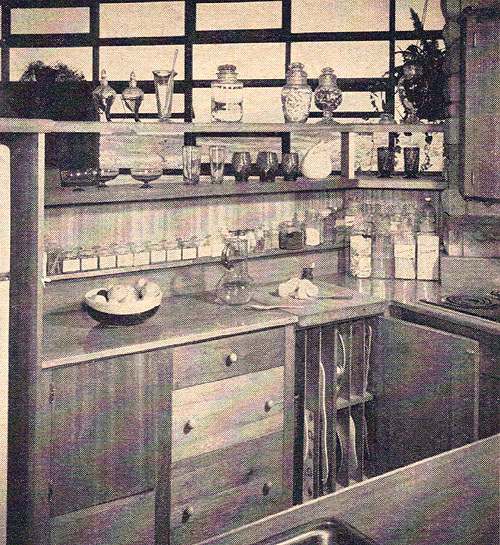 |
|
8) "Open shelves above
divider handsomely display glass collection without shutting
off light from window wall in living room. Storage in
kitchen, as throughout house, is carefully planned for
maximum usefulness. Stainless steel sink (foreground) has a
garbage disposal unit." Page 27. |
| |
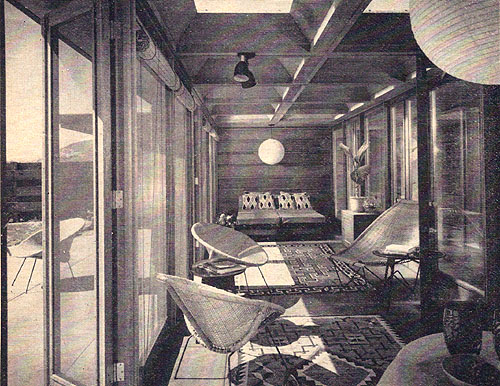 |
|
9) "You can have pleasant
outdoor living the year round in a porch that extends into a
terrace. Light floods it from glass-and-beams ceiling above,
wall of glass doors at left. (Screens replace glass in
summer.) From here, light brightens kitchen and whole
interior." Page 27. |
| |
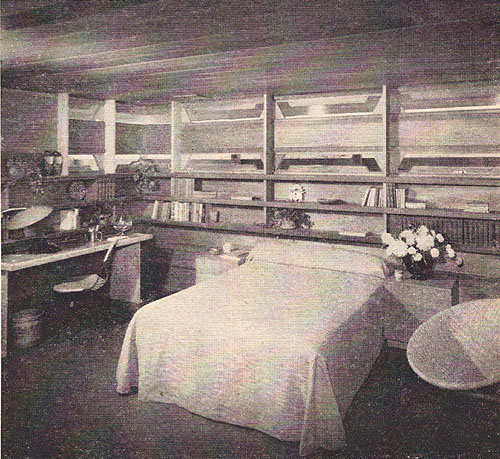 |
|
10) "Quintin's and Ruth's
bedroom has high, narrow glass inserts for light. Handy
built-in bookshelves contribute architectural interest. Desk
was designed by Mr. Wright. Out of picture at right are two
closets, at left the door to bathroom and storage wall shown
below." Page 70. (Looking toward the west corner.) |
| |
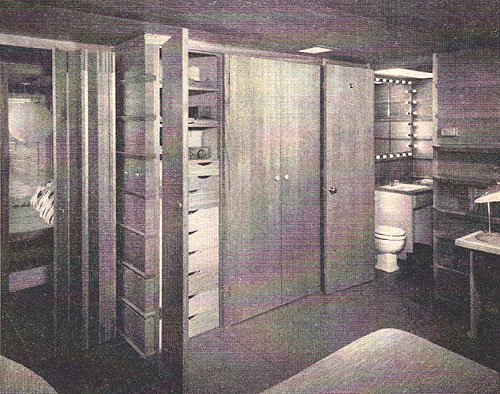 |
|
11) "Lighting in bathroom is
provided by large dome skylight. Idea for bulbs around
mirror was borrowed from stage dressing rooms - they give
even, natural light. Wide folding door at left is made from
boards joined by piano hinges; it lets light in from the
porch." Page 70. (Looking toward the south.) |
| |
| |
|
|
|
|
|
|
|
THE FULLER BRUSH MAGAZINE 1962 |
|
|
|
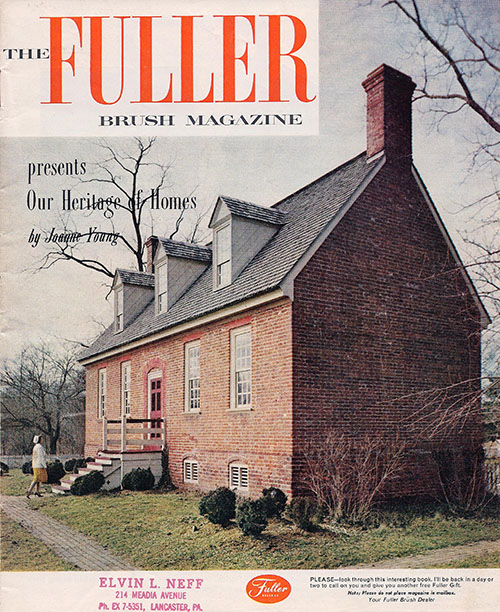 |
|
"Our Heritage of
Homes." The back page is
devoted to the Quintin Blair Home (1952 - S.351). "When
Frank Lloyd Wright
first began designing his "Prairie houses"
eccentric was one of the milder terms used to describe his work. Even
today a
Frank Lloyd Wright
house such as the one above built for the
Quintin Blairs of Cody, Wyoming -- arouses so much interest that
homeowners find they're suddenly one of the sightseeing wonders of their
hometown!" Includes one photograph by Warren Reynolds Photography, Inc.
taken in 1956. (S#1526.14.1011) |
| |
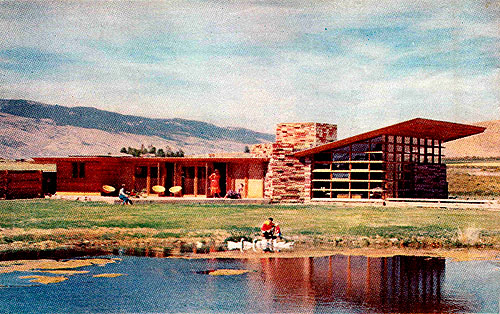 |
|
From the back page of "The
Fuller Brush Magazine". |
| |
|
|
|
|
|
|
|
|
BLAIR
RESIDENCE 1989 (NRHP) |
|
|
|
|
The Blair Residence was placed
on the National Register of Historic Places in 1991. On
March 14, 1989 Richard Collier recorded these images for theNational Registry of Historic
Places. The Garage and Storage rooms
have been added, but the Master Bedroom has not. |
|
|
 |
|
1) Viewed from the East. The
large stained glass light fixture on a pedestal is from the
demolished
Yellowstone Canyon Hotel. The original Workshop on the
far left, is obscured from view. The enclosed Terrace with floor to
ceiling windows and doors that open outward is in the center.
Originally designed as a Hallway and Terrace, the roof was extended
outward, the Terrace enclosed and is now used as the dining room.
The ceiling was deeply coffered with skylights. Just to the right is
the Workspace covered in stonework. A window faces the enclosed
Terrace. The original Dining and Living Room are on the right. |
|
|
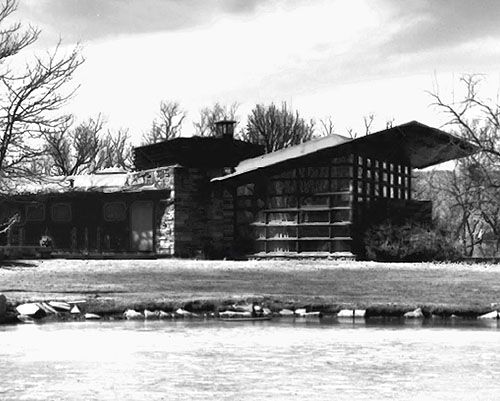 |
|
1B) Detail. The enclosed Terrace with floor to
ceiling windows and doors that open outward is on the left.
Originally designed as a Hallway and Terrace, the roof was extended
outward, the Terrace enclosed and is now used as the dining room.
The ceiling was deeply coffered with skylights. In the center is
the Workspace covered in stonework. A window faces the enclosed
Terrace. The original Dining and Living Room are on the right. |
|
|
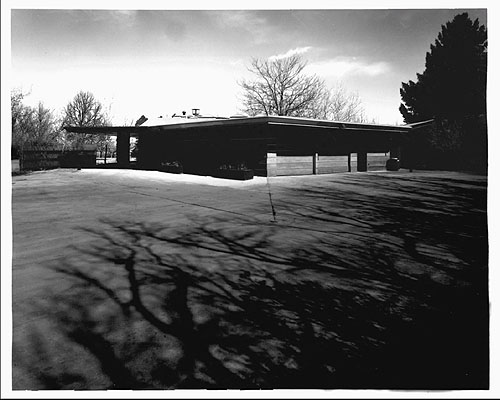 |
|
2) Viewed from the Southwest.
The Garage on the right was not part of Wright's original
design and was a later addition. |
|
|
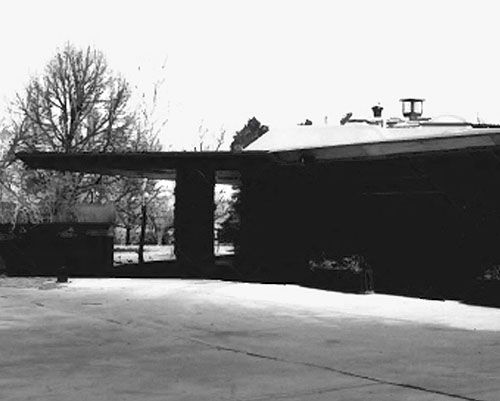 |
|
2B) Detail. View before
Master Bedroom was added on the left. |
|
|
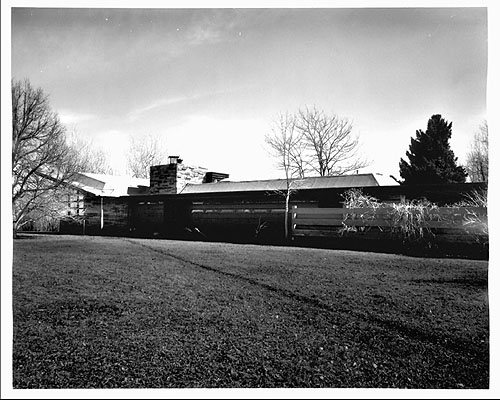 |
|
3) Viewed from the West
before Master Bedroom was added. Entry is in the center to
the right of the Living Room. The double row of
cut-wood light screen bedroom windows are visible on the
right. |
|
|
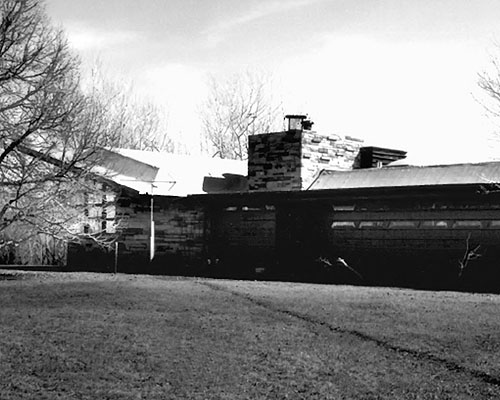 |
|
3B) Detail. The Entry is in
the center to the right of the Living Room. The double
row of cut-wood light screen bedroom windows are visible on
the right. |
|
|
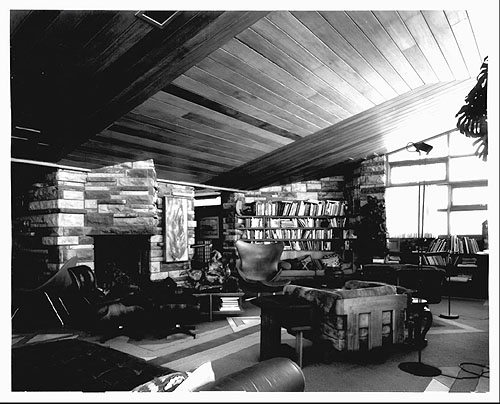 |
|
4) Viewed from the East. The
ceiling rises upward toward the window walls on the right.
The Living Room fireplace has a mantle that extends out at a
45 degree angle echoing the design of the piano alcove on
the opposite wall. Built-in seating and shelves cover the
wall in the center. Built-in shelves cover the short wall on
the right. |
|
|
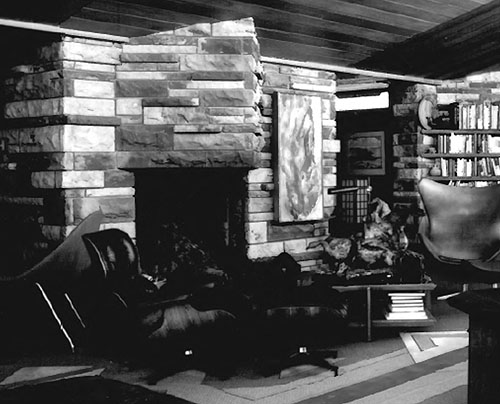 |
|
4B) Detail. The Living Room
fireplace has a mantle that extends out at a 45 degree angle
echoing the design of the piano alcove on the opposite wall.
Built-in seating (obscured) and shelves cover the wall on
the right. |
|
|
|
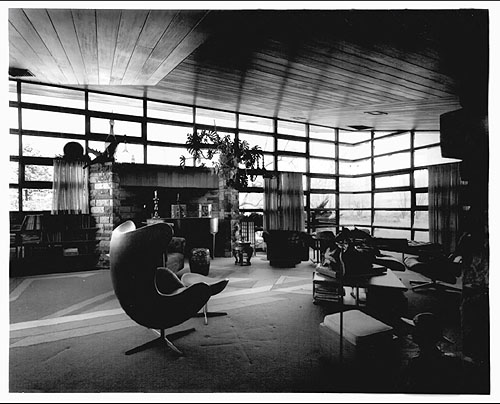 |
|
5) Viewed from the West. The
ceiling rises upward toward the window walls, opening the
room to the outdoors. The pattern of the boards extends
through the walls to the wide overhang, stressing the
indoor-outdoor unity of design. The piano alcove which
intersects the glass wall, extends out at a 45 degree angle
echoing the design of the fireplace on the opposite wall. |
|
|
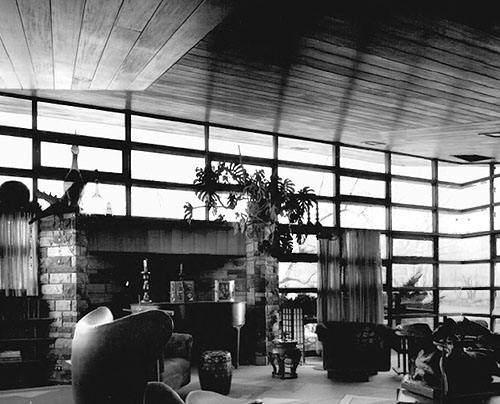 |
| 5B)
Detail. The ceiling rises upward toward the window walls,
opening the room to the outdoors. The pattern of the boards
extends through the walls to the wide overhang, stressing
the indoor-outdoor unity of design. The piano alcove which
intersects the glass wall, extends out at a 45 degree angle
echoing the design of the fireplace on the opposite wall. |
| |
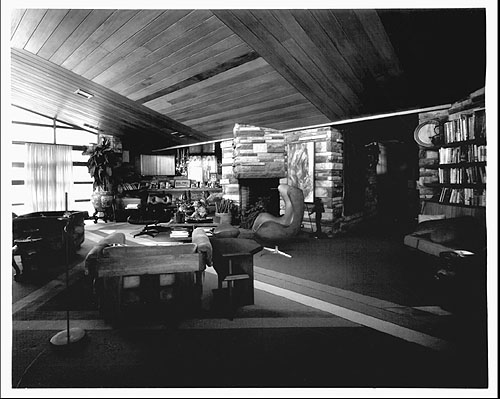 |
| 6) Viewed
from the North. The ceiling rises upward toward the window
walls on the left. The original Workspace is to the left of
the fireplace. The Living Room fireplace has a mantle that
extends out at a 45 degree angle echoing the design of the
piano alcove on the opposite wall. Built-in seating and
shelves cover the wall on the right. |
| |
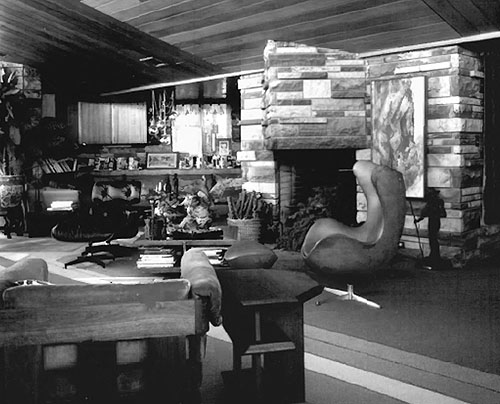 |
| 6B)
Detail. The original Workspace is to the left of the
fireplace. The Living Room fireplace has a mantle that
extends out at a 45 degree angle echoing the design of the
piano alcove on the opposite wall. |
|
|
|
|
|
|
|
|
|
|
|
Exterior
Photographs By Douglas M. Steiner, August 2009 |
|
|
|
|
Quintin and Ruth Blair Residence, Cody,
Wyoming (1952 - S.351). Set of 58 exterior photographs of
the Blair Residence. There are many classic Wright details
in the two bedroom home. Three sides of the Living and
Dining Room are walls of glass, one and a half of which are
floor to ceiling. There are windows with mitered corners.
The Living Room roof cantilevers out eight feet. The
original carport had a roof that cantilevers out 12 feet.
There are built in shelves, seating and lighting. The
centrally located fireplace has a mantle that extends out at
a 45 degree angle. There are horizontal rows of floor to
ceiling vertical door and windows, double doors that open
outward, clerestory windows, cut-wood light screens. And a
hidden entrance. |
|
Changes and additions have taken place over the years. They
hired Bruce Goff, the architect that introduced Ruth to
Wright, to enclose the terrace and create a dining room,
enlarge the kitchen, and add a two car garage. According to
Randolph C. Henning, the Blair residence (to the best of his
recollection), is the only time the architectural genius of
both Wright & Bruce Goff physically came together in an
architectural work. He also mentioned that Michael Kreps was
the Bruce Goff apprentice who was responsible for the
drawings for the 1981 additions. After Bruce passed away,
Charles Montooth was hired to design a master bedroom.
Set of 58 exterior color high res
photographs.
(ST#2009.61.0809 - 1-58) |
|
|
 |
|
1)
The Blairs purchased a large
tract of land a few miles east of Cody. They began planting
a wide variety of trees, which today is barely visible from
the road. View is looking South toward the residence.
(ST#2009.61.0809-1) |
|
|
|
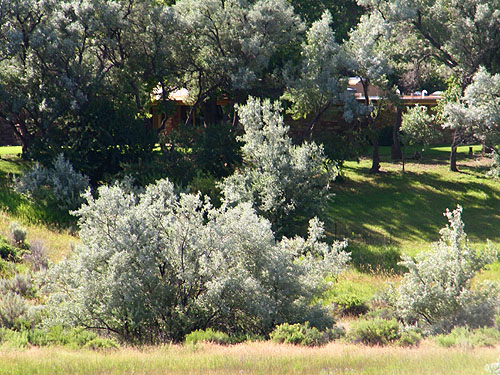 |
|
2)
Viewing the property today,
with all its lush vegetation, it is hard to image how barren
and desolate it look in 1952.
(ST#2009.61.0809-2) |
|
|
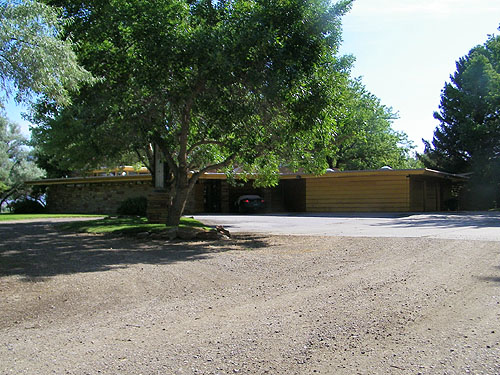 |
|
3)
Viewed from the Southwest as
you approach the home.
The Master Bedroom on the left and Garage on the right were
later additions and not part of Wright's original design.
(ST#2009.61.0809-3) |
|
|
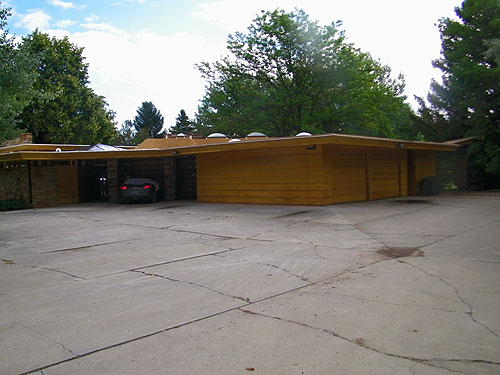 |
|
4)
Viewed from the Southwest.
The Garage on the right was not part of Wright's original
design and was a later addition.
(ST#2009.61.0809-4) |
|
|
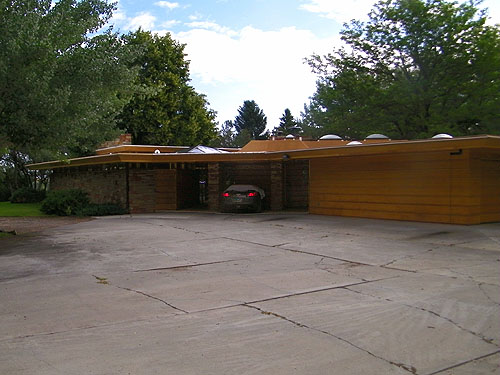 |
|
5)
Viewed from the Southwest.
The Master Bedroom on the left was not part of Wright's
original design and was a later addition. The Entry is to
the left of the stone columns.
(ST#2009.61.0809-5) |
|
|
|
|
|
|
|
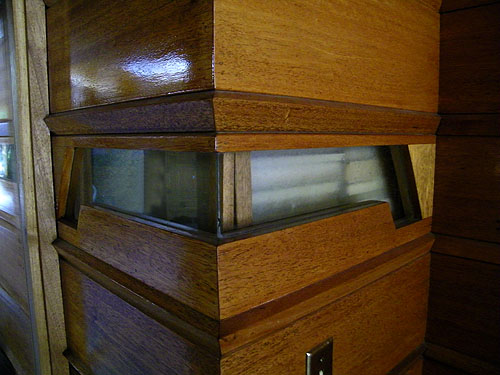 |
|
11) Western corner of the
bedroom. Detail of the exterior paneling and lower row of
cut-wood light screen window with mitered glass corner.
(ST#2009.61.0809-11) |
| |
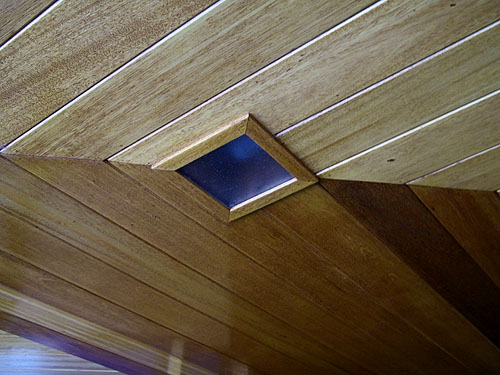 |
| 12) Original
built-in light fixture in the carport ceiling.
(ST#2009.61.0809-12) |
| |
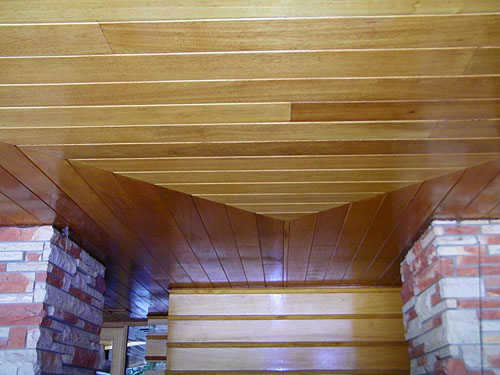 |
| 13) Ceiling design
in the carport.
(ST#2009.61.0809-13) |
| |
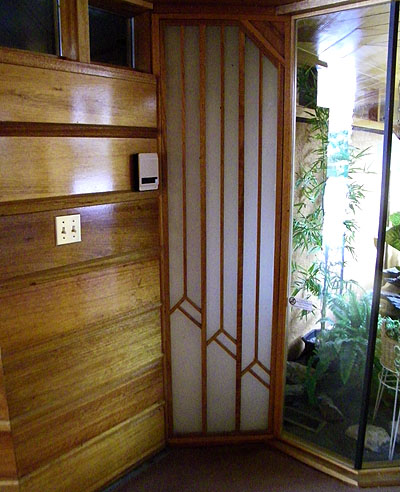 |
| 14) The Master
Bedroom is on the left, Light screen and Atrium to the right. The
Front Door is just to the right (out of the photograph).
(ST#2009.61.0809-14) |
| |
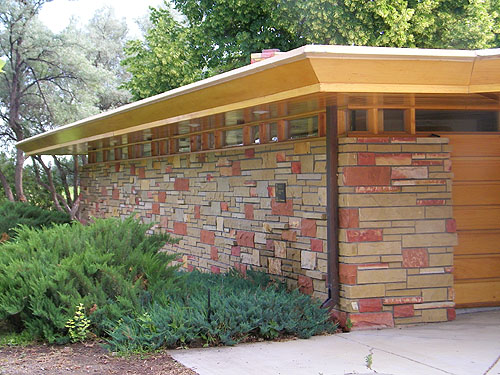 |
| 15) Master Bedroom
viewed from the West. As we continue in a clockwise direction, the
continuity of Wright's original design is maintained. Consistency of
material. Broad overhangs.
(ST#2009.61.0809-15) |
| |
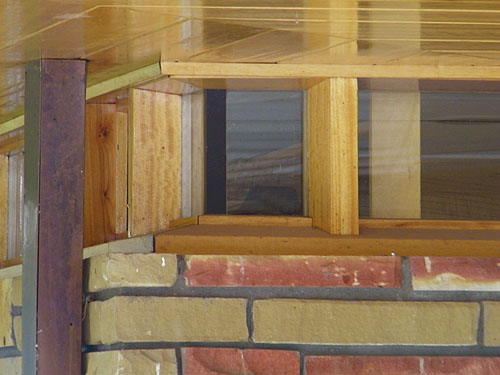 |
| 16)
Detail of the Western corner of the Master Bedroom. The
exterior wood paneling of the original Bedrooms allowed for an upper
and lower row of cut-wood light screen windows. The addition
of the Master Bedroom followed the stone and window design of the
Living Room, including mitered glass corners.
(ST#2009.61.0809-16) |
| |
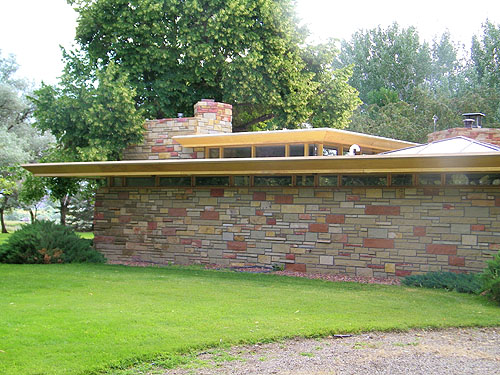 |
| 17) Although
Wright did not include raised clerestory windows in the original
design, it was a constant theme in many of his designs and was
picked up in the addition of the Master Bedroom.
(ST#2009.61.0809-17) |
| |
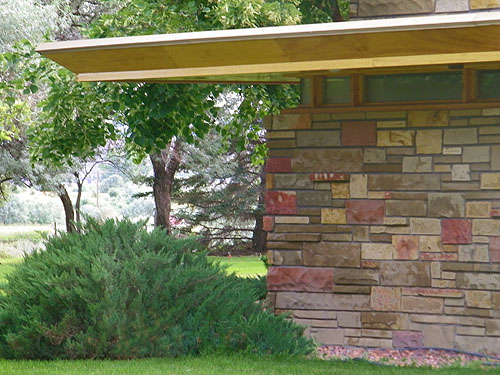 |
| 18) Detail of the
broad overhand of the roof line.
(ST#2009.61.0809-18) |
| |
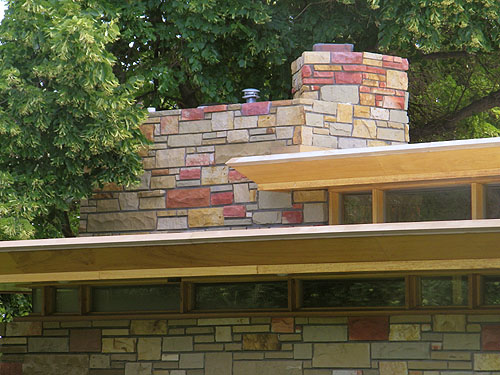 |
| 19) Detail of the
raised clerestory windows and massive stone fireplace in the Master Bedroom.
(ST#2009.61.0809-19) |
| |
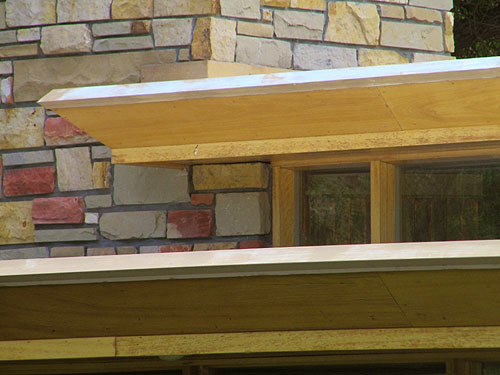 |
| 20) Detail of the
raised clerestory windows in the Master Bedroom.
(ST#2009.61.0809-20) |
| |
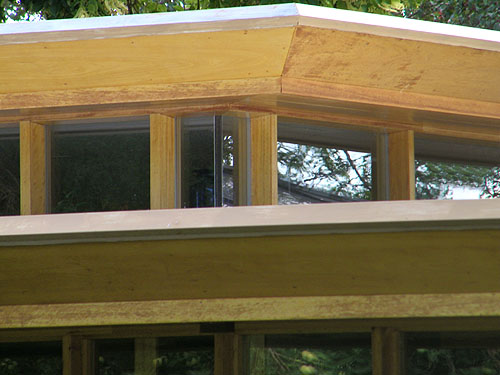 |
| 21) Detail of the
clerestory glass cornered window.
(ST#2009.61.0809-21) |
| |
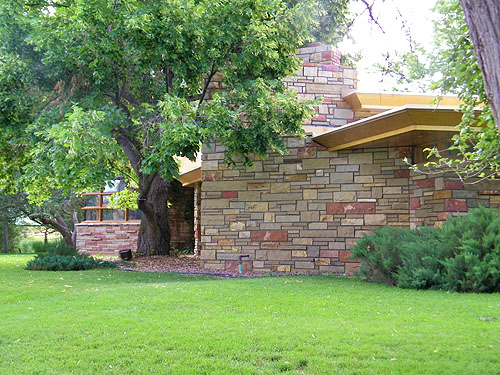 |
|
22) Viewed from
the West. As you move
past the massive stone fireplace you see the original Living Room
for the first time. The Master Bedroom is on the right.
(ST#2009.61.0809-22) |
| |
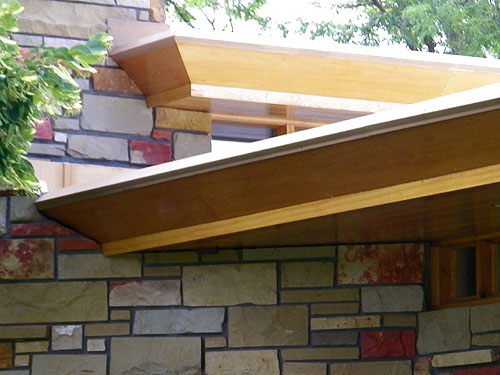 |
| 23) Detail of the
roof line intersecting the stone work.
(ST#2009.61.0809-23) |
| |
|
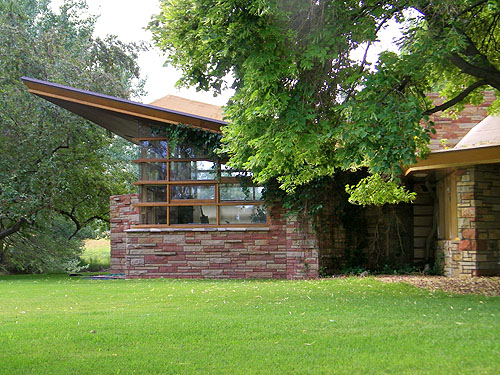 |
| 24) Viewed from
the Northwest. The roof seems to float above the Living Room. The
piano alcove extends out on the left. The mitered glass windows on
the left allow you to see right through the corner of the Living
Room. Built in shelves cover
the interior of the short wall. Built in seating and shelves
cover the interior of the wall that extends out on the right side of
the Living Room. The Master Bedroom is on the far right.
(ST#2009.61.0809-24) |
| |
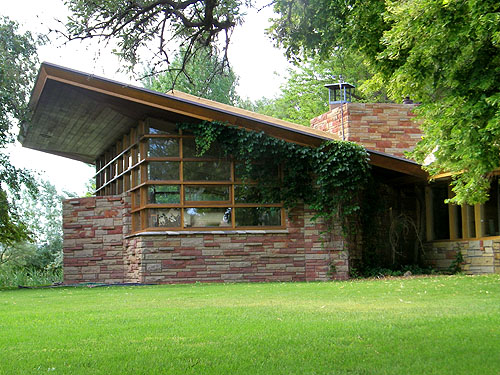 |
| 25) Viewed from
the North Northwest. The roof seems to float above the Living Room. The
piano alcove extends out on the left. Built in shelves cover
the interior of the short wall. Built in seating and shelves
cover the interior of the wall that extends out on the right side of
the Living Room. The stonework from the massive fireplace and
Utility Room can be seen above the Living Room on the right. The Master Bedroom is on the far right.
(ST#2009.61.0809-25) |
| |
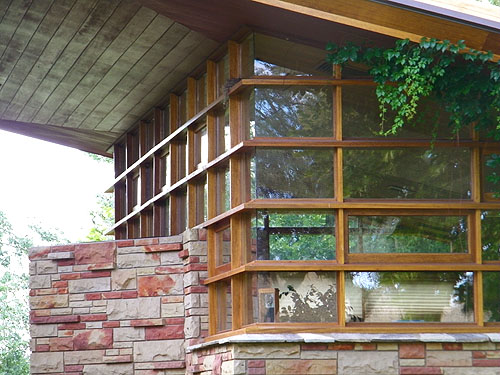 |
| 26) The roof
cantilevers out past the Living Room's glass wall. The
piano alcove extends out on the left. The mitered glass windows
dissolve the corners of the Living Room. Some windows open outward
to allow air into the Living Room.
(ST#2009.61.0809-26) |
| |
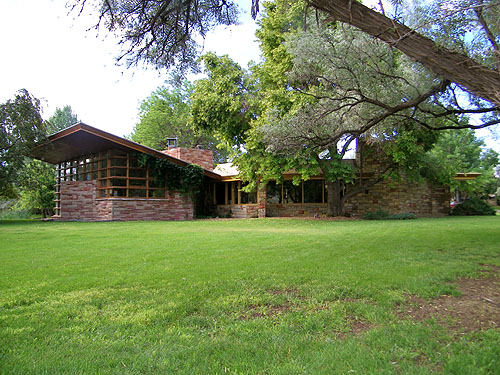 |
| 27) Viewed from
the North. The roof seems to float above the Living Room. The
piano alcove extends out on the left. Built in shelves cover
the interior of the short wall. Built in seating and shelves
cover the interior of the wall that extends out on the right side of
the Living Room. The stonework from the massive fireplace and
Utility Room can be seen above the Living Room on the right. The Master Bedroom is on the far right.
(ST#2009.61.0809-27) |
| |
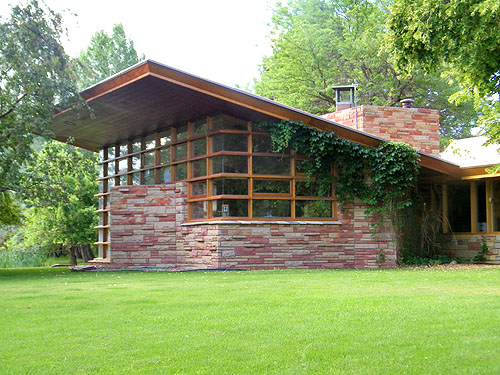 |
|
28) The roof seems to float above the Living Room. The
piano alcove extends out on the left. Built in shelves cover
the interior of the short wall. Built in seating and shelves
cover the interior of the wall that extends out on the right side of
the Living Room. The stonework from the massive fireplace and
Utility Room can be seen above the Living Room on the right. The Master Bedroom is on the far right.
(ST#2009.61.0809-28) |
| |
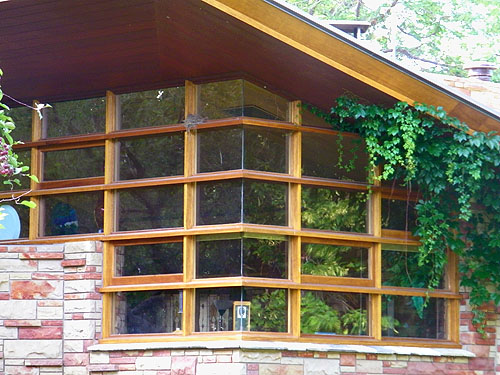 |
| 29) The
roof seems to float above the Living Room. The piano alcove extends
out on the left. Built in shelves cover the interior of the short
wall. The mitered glass windows dissolve the corners of the
Living Room. Some windows open outward to allow air into the Living
Room. (ST#2009.61.0809-29) |
| |
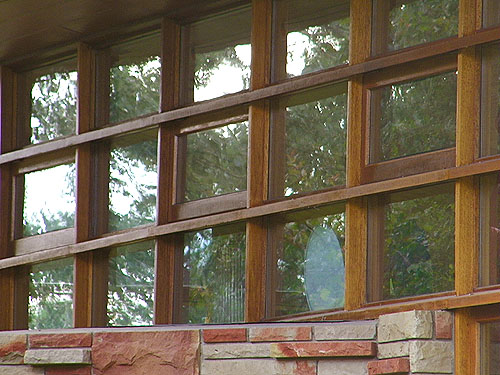 |
| 30) Some windows
open outward to allow air into the Living Room.
(ST#2009.61.0809-30) |
| |
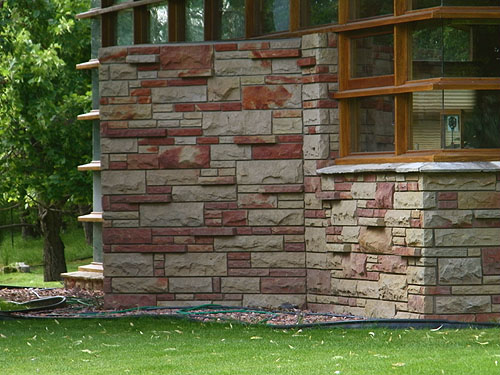 |
| 31) The piano
alcove extends out on the left. Built in shelves cover the interior
of the short wall.
(ST#2009.61.0809-31) |
| |
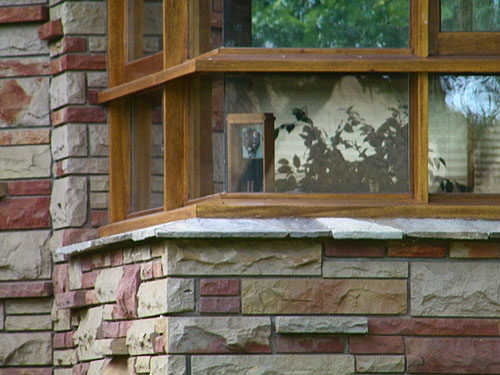 |
| 32) The
piano alcove extends out on the left. Built in shelves cover
the interior of the short wall. The mitered glass windows dissolve
the corners of the Living Room.
(ST#2009.61.0809-32) |
|
|
|
 |
|
Photographed in 1956. Viewed
from the East. The Workshop is on the far left, the enclosed Terrace
with floor to ceiling windows and doors that open outward is in the
center. Originally designed as a Hallway and Terrace, the roof was
extended outward and the Terrace enclosed, later to be used as the
dining room. The ceiling was deeply coffered with skylights. Just to
the right is the Workspace (Kitchen) covered in stonework. A window
faces the enclosed Terrace. The Dining and living room are on the
right. This view accentuates Wright's cantilevered roof over the
Living and Dining Room. Copyright June 1956, from the cover of
Household Magazine, Reynolds Photography, Inc. |
| |
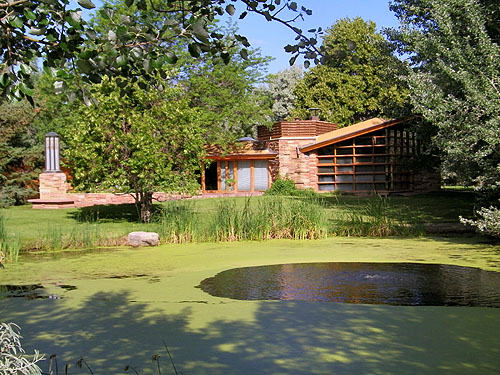 |
|
33) Viewed from the East. The
large stained glass light fixture on a pedestal is from the
demolished
Yellowstone Canyon Hotel. The original Workshop on the
far left, is obscured from view. The enclosed Terrace with floor to
ceiling windows and doors that open outward is in the center.
Originally designed as a Hallway and Terrace, the roof was extended
outward, the Terrace enclosed and is now used as the dining room.
The ceiling was deeply coffered with skylights. Just to the right is
the Workspace covered in stonework. A window faces the enclosed
Terrace. The original Dining and Living Room are on the right.
(ST#2009.61.0809-33) |
| |
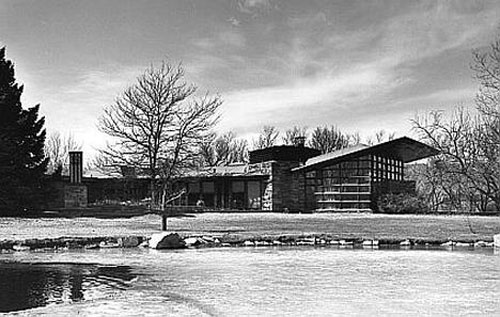 |
| Circs 1990s,
Copyright State of Wyoming, National Registry of Historic Places. |
| |
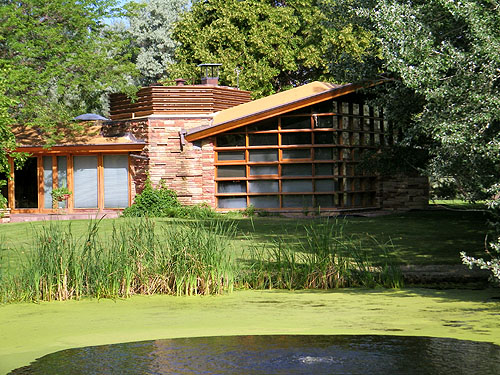 |
|
34) The enclosed Terrace
with floor to ceiling windows and doors that open outward is on the
left. Originally designed as a Hallway and Terrace, the roof
was extended outward, the Terrace enclosed and is now used as the
dining room. The ceiling was deeply coffered with skylights. The
Workspace covered in stonework is in the center. A window faces the
enclosed Terrace. The enclosure on the roof of the Workspace was
added to obscure upgraded utilities. The flat roofs were
structurally redesigned. The original Dining and living room are on
the right.
(ST#2009.61.0809-34) |
| |
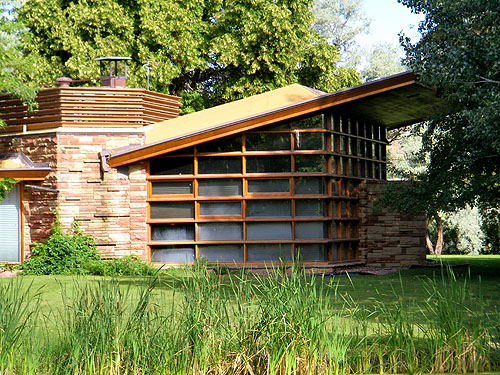 |
|
35) The Workspace covered in
stonework is on the left. A window faces the enclosed Terrace. The
enclosure on the roof of the Workspace was added to obscure upgraded
utilities. The flat roofs were structurally redesigned. The original
Dining and living room are on the right. The roof cantilevers out
over the floor to ceiling wall of glass. The piano alcove extends
out on the right.
(ST#2009.61.0809-35) |
| |
 |
| Photographed in 1956.
Viewed from the East. The Workshop is on the far left, the roof is
cantilevered. The enclosed Terrace with floor to ceiling windows and
doors that open outward is just to the right. Just to the right of
the Terrace is the Workspace covered in stonework. The Dining and
Living Room are on the right. This view accentuates Wright's
cantilevered roof, the walls of glass, and the 45 degree angle of
the Workspace and piano alcove. The dramatic angle of the Workshop
is lessened with the revisions. Copyright June 1956,
Household Magazine Reynolds Photography, Inc. |
| |
 |
| Detail: This view accentuates Wright's
cantilevered roof, the walls of glass, and the 45 degree angle of
the Workspace and piano alcove. The mitered glass windows dissolve
the corners of the Living Room. Copyright June 1956,
Household Magazine, Reynolds Photography, Inc. |
| |
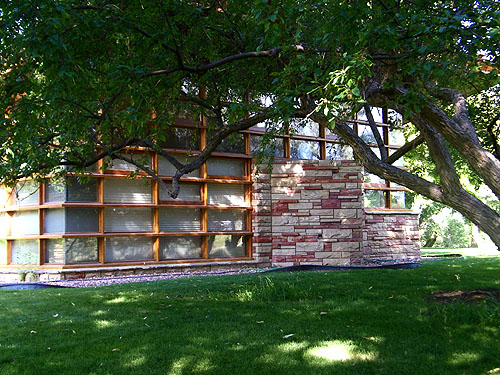 |
|
36) The same angle as above
is now partially obscured by mature trees planted by the Blairs. The
roof cantilevers out over the floor to ceiling wall of glass. The
piano alcove extends out on the right.
(ST#2009.61.0809-36) |
| |
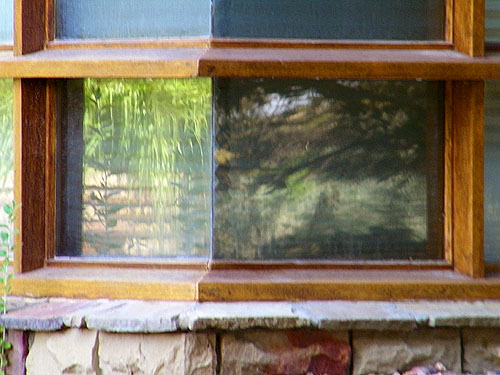 |
|
37) Detail of the lower left
mitered glass corner window.
(ST#2009.61.0809-37) |
| |
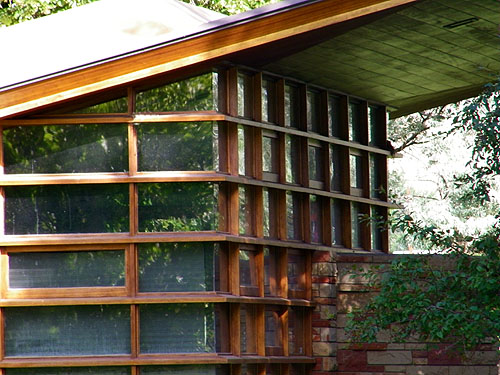 |
|
38) The roof cantilevers out
over the floor to ceiling wall of glass. The roofs were structurally
redesigned. The piano alcove extends out on the right.
(ST#2009.61.0809-38) |
| |
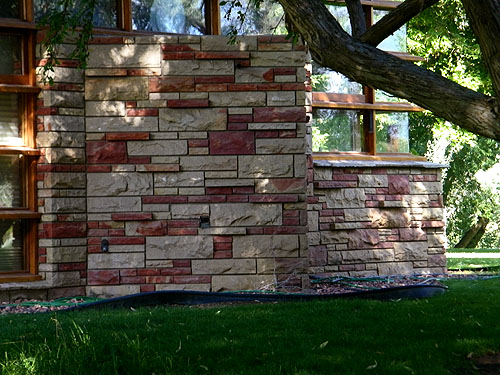 |
|
39) The piano alcove extends
out at a 45 degree angle. Built in shelves cover the interior of the
short wall on the right.
(ST#2009.61.0809-39) |
| |
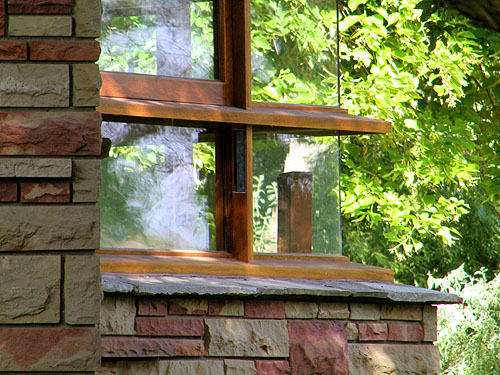 |
|
40) The piano alcove is on
the left. The mitered glass windows dissolve the corners of the
Living Room. Built in shelves cover the interior of the short wall
on the right.
(ST#2009.61.0809-40) |
| |
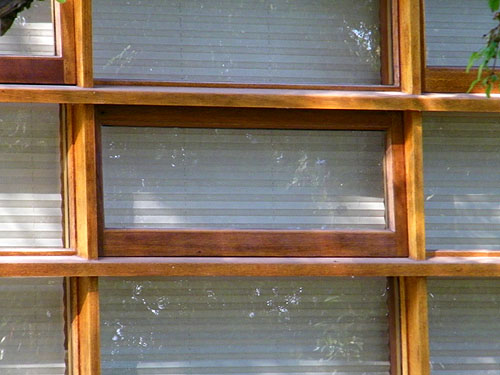 |
|
41) Some windows are
designed to open outward to allow fresh air into the Living Room.
(ST#2009.61.0809-41) |
|
|
|
 |
| Photographed in 1956.
Viewed from the East. The Workshop is on the far left, the roof is
cantilevered. The enclosed Terrace with floor to ceiling windows and
doors that open outward is just to the right. Just to the right of
the Terrace is the Workspace covered in stonework. The Dining and
Living Room are on the right. Copyright June 1956,
Household Magazine, Reynolds Photography, Inc. |
| |
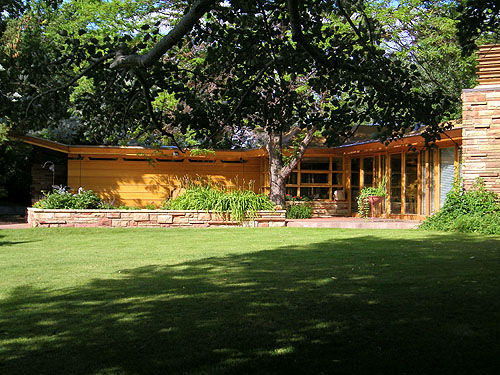 |
| 42) Viewed from
the East. The Storage on the left is an addition, but the originally
designed board and batten styled siding was retained. The original
Workshop which in now in the center, was converted to the Kitchen,
and the board and batten siding was replace by windows. A stone
planter was added along the base of the windows. The enclosed Terrace with floor to
ceiling windows and doors that open outward is to the right of the
Kitchen.
The original Workspace covered in stonework is on the far right. It
was been converted to a Library.
(ST#2009.61.0809-42) |
| |
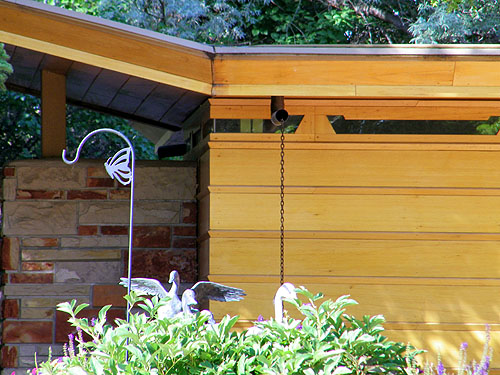 |
| 43) This Storage
area is an addition, but the originally designed board and batten
styled siding was retained. The slanted roof on the left matches the
pitch of the Living Room. The row of cut-wood light screen windows
are consistent with the upper row in the
Entry.
(ST#2009.61.0809-43) |
| |
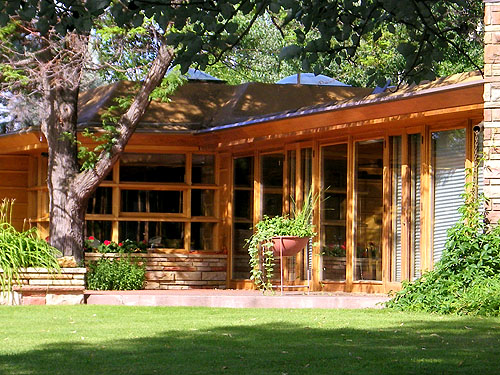 |
| 44) The original
Workshop on the left, was converted to the Kitchen and the board and
batten siding was replace by windows. A stone planter was added
along the base of the windows. The enclosed Terrace with floor to
ceiling windows and two sets of doors that open outward is to the
right.
(ST#2009.61.0809-44) |
| |
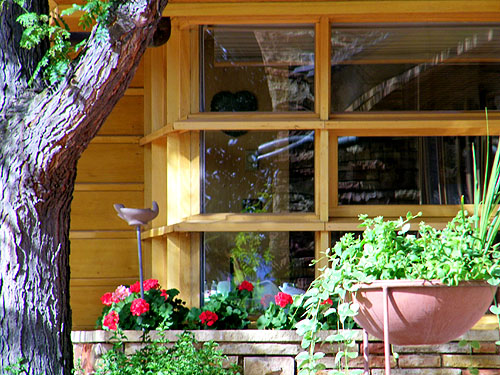 |
| 45) The original
Workshop was converted to the Kitchen and the board and batten
siding was replace by windows. A stone planter was added along the
base of the windows.
(ST#2009.61.0809-45) |
| |
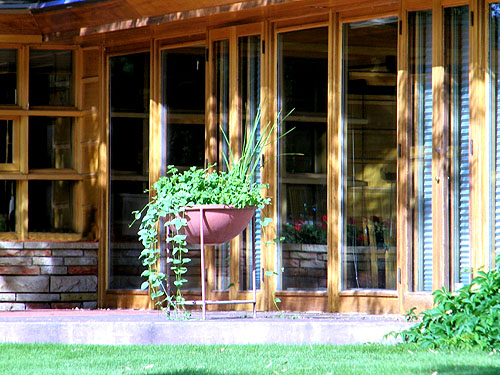 |
| 46) The original
Workshop which was converted to the Kitchen is on the left. The enclosed Terrace with floor to
ceiling windows and two sets of doors that open outward is to the
right.
(ST#2009.61.0809-46) |
| |
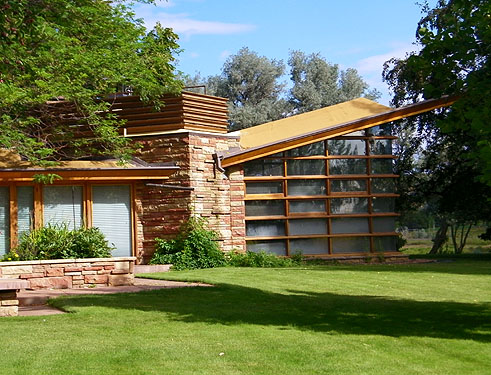 |
| 47) Viewed from
the Southeast. The enclosed Terrace with floor to ceiling windows
and doors that open outward is on the left. Originally designed as a
Hallway and Terrace, the roof was extended outward, the Terrace
enclosed and is now used as the dining room. The ceiling was deeply
coffered with skylights. The stone planter was an addition. The
original Workspace, covered in stonework has been converted to a
Library. A window faces the enclosed Terrace. The enclosure on
the roof of the Workspace was added to obscure upgraded utilities.
The flat roofs were structurally redesigned. The original Dining and
living room are on the right.
(ST#2009.61.0809-47) |
| |
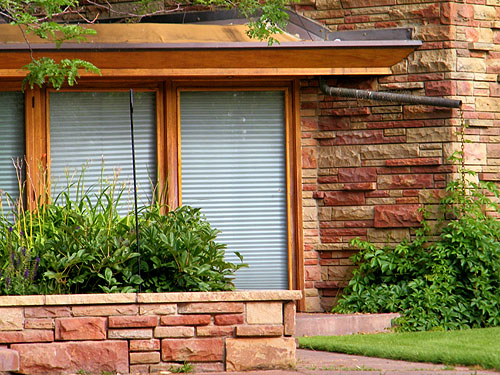 |
| 48) The enclosed
Terrace with floor to ceiling windows and doors that open outward is
on the left. Originally designed as a Hallway and Terrace, the roof
was extended outward, the Terrace enclosed and is now used as the
dining room. The ceiling was deeply coffered with skylights. The
stone planter was an addition. The original Workspace, covered in
stonework is on the right.
(ST#2009.61.0809-48) |
| |
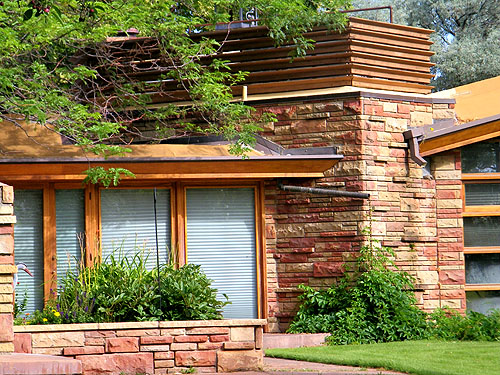 |
| 49) The enclosed
Terrace with floor to ceiling windows and doors that open outward is
on the left. Originally designed as a Hallway and Terrace, the roof
was extended outward, the Terrace enclosed and is now used as the
dining room. The ceiling was deeply coffered with skylights. The
stone planter was an addition. The original Workspace, covered in
stonework has been converted to a Library. A window faces the
enclosed Terrace. The enclosure on the roof of the Workspace was
added to obscure upgraded utilities. The original Dining and living
room are on the right.
(ST#2009.61.0809-49) |
| |
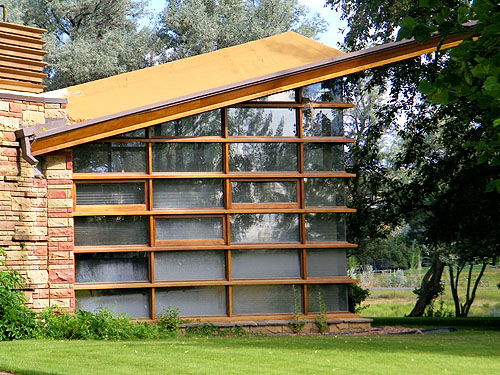 |
| 50) The original
Dining and living room are on the right. The mitered glass windows
dissolve the corners of the Living Room. The flat roofs were
structurally redesigned.
(ST#2009.61.0809-50) |
| |
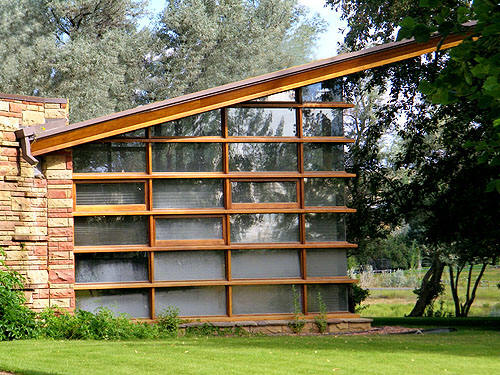 |
| 51) Through the
magic of Photoshop we are able to envision Wright's original design.
When removing the structural changes (i.e. the enclosure above the
Workspace and the changes to the roof), the cantilevered roof floats
above a wall of glass. The mitered glass windows dissolve the
corners of the Living Room.
(ST#2009.61.0809-51) |
| |
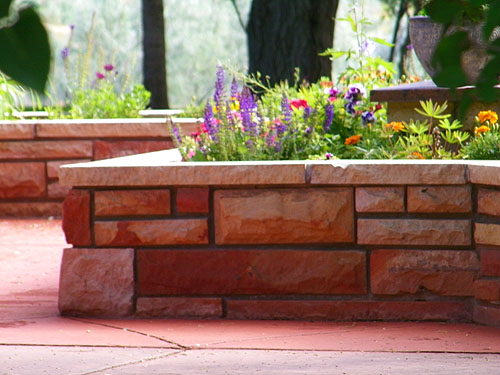 |
| 52) The Terrace
was expanded and stone planters were added.
(ST#2009.61.0809-52) |
|
|
|
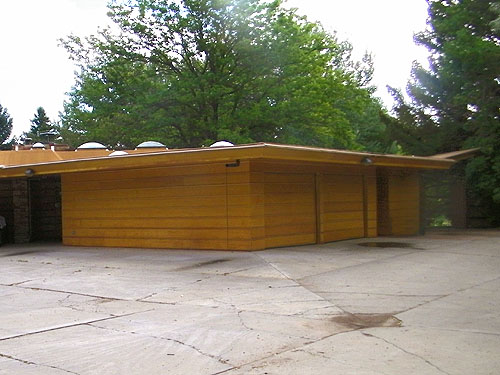 |
| 53) Viewed from
the Southwest. The original Carport is on the far left. The Garage
in the center and storage on the right were not part of Wright's
original design and were later additions. The originally designed
board and batten styled siding was retained.
(ST#2009.61.0809-53) |
| |
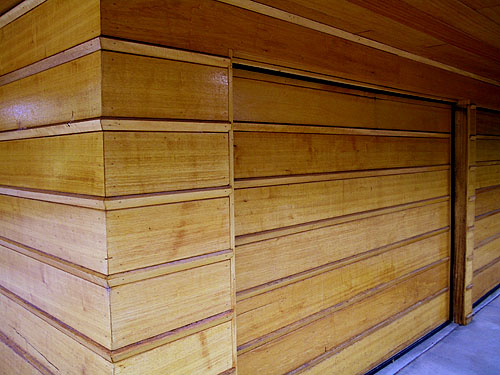 |
| 54) The Garage
was not part of Wright's original design and was a later addition.
The originally designed board and batten styled siding was retained.
(ST#2009.61.0809-54) |
| |
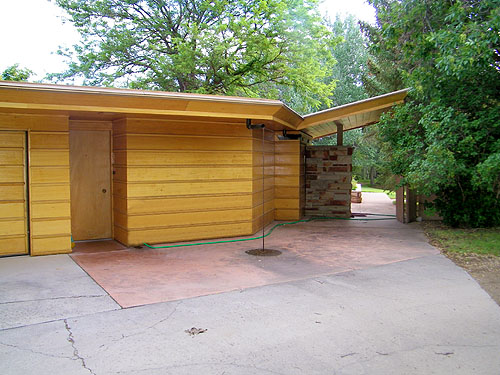 |
| 55) The Garage,
on the far left, and storage on the right were not part of Wright's
original design and were later additions. The slanted roof on the
right matches the pitch of the Living Room. The row of cut-wood
light screen windows are consistent with the upper row in the
Entry. The originally designed board and batten
styled siding was retained.
(ST#2009.61.0809-55) |
| |
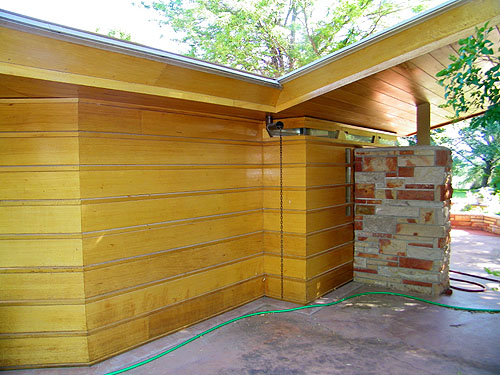 |
| 56) The storage
areas were not part of Wright's original design and were later
additions. The slanted roof on the right matches the pitch of the
Living Room. The row of cut-wood light screen windows are consistent
with the upper row in the
Entry. The
originally designed board and batten styled siding was retained.
(ST#2009.61.0809-56) |
| |
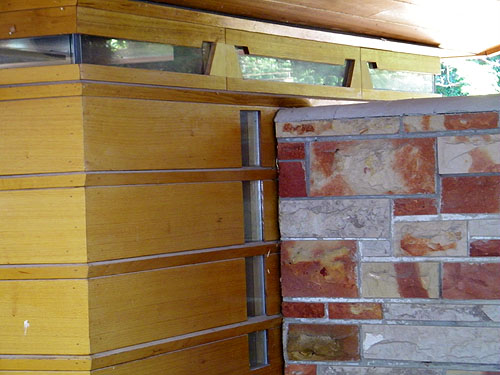 |
| 57) The storage
areas were not part of Wright's original design and were later
additions. The row of cut-wood light screen windows are consistent
with the upper row in the
Entry. The
originally designed board and batten styled siding was retained.
(ST#2009.61.0809-57) |
| |
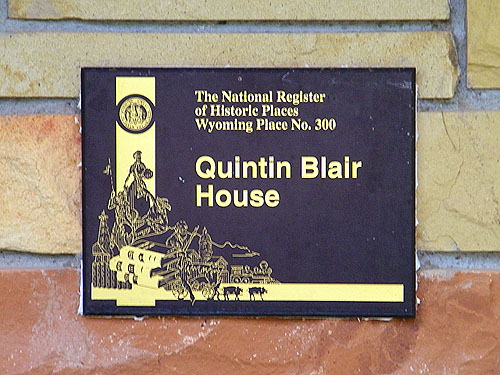 |
| 58) While Ruth was
probably the impetus for selecting Wright, Quintin was just as involved in the process. Like
many of Wright’s clients, he supervised the construction
himself. The Blair House was placed on the National Register
of Historic Places in 1991.
(ST#2009.61.0809-58) |
|
|
|
|
Text and Photographs by Douglas M. Steiner, Copyright
2009. |
|
|
|
|
|
|
|
|
|
|
Wright Designed Furniture |
|
|
|
|
There are many classic Wright
details in this two bedroom home. There are built in
shelves, seating and lighting throughout the home. There are
Wright designed chairs and hassocks, coffee, end, and dining
tables in the Living and Dining Rooms. There is a Wright
designed desk in the Bedroom. |
|
|
|
Blair Residence Furniture 1956 |
 |
|
1) There are Wright designed
chairs and hassocks, coffee, and end tables in the Living
Rooms. These appeared in many of the Usonian homes Wright
designed during this time period. (Household Magazine, June
1956, Photography by Warren Reynolds. Page 26.) |
|
|
 |
|
2) There are Wright designed
chairs and hassocks, coffee, end and dining tables in the
Living and Dining Rooms. The Living Room also included
built-in shelves and seating. These appeared in many of the Usonian homes Wright designed during this time period.
(Household Magazine, June 1956, Photography by Warren
Reynolds. Page 26.) |
| |
 |
|
3) The Workspace included
built-in cabinets, shelves and lighting. (Household Magazine,
June 1956, Photography by Warren Reynolds. Page 27.) |
| |
 |
|
4) The Workspace included
built-in cabinets, shelves and lighting. (Household Magazine,
June 1956, Photography by Warren Reynolds. Page 27.) |
|
|
 |
|
5) The Blair's Bedroom included
built-in shelves and lighting. The desk
on the left was designed by Wright. (Household Magazine,
June 1956, Photography by Warren Reynolds. Page70.) |
| |
 |
|
6) The Blair's Bedroom included
built-in shelving and lighting. Lighting in bathroom is
provided by a large dome skylight. The wide accordion door
on the left is made from
boards joined by piano hinges which allows lets light in from the
porch when open." (Household Magazine,
June 1956, Photography by Warren Reynolds. Page70.) |
| |
| |
|
Blair Residence Furniture 1989 |
 |
|
7) A few pieces of Wright
designed furniture still remain in the Living Room in 1989. Built-in seating and shelves cover the
wall in the center. Built-in shelves cover the short wall on
the right. There are Wright designed coffee and end tables
in the Living Room. (National Registry of Historic
Places, March 14, 1989, Photography by Richard Collier.) |
|
|
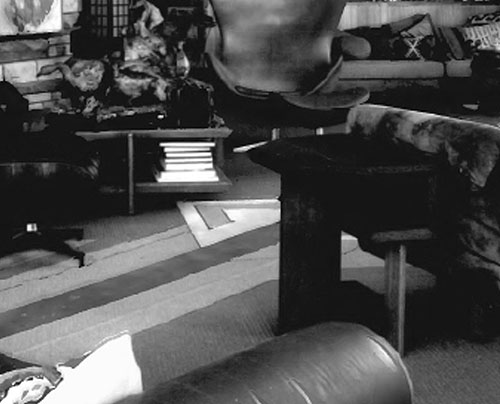 |
|
8) Detail of the Wright designed
coffee and end tables in the Living Room. (National Registry of Historic
Places, March 14, 1989, Photography by Richard Collier.) |
| |
 |
|
9) Another view of the Wright
designed coffee table and hassock in the Living Room. (National Registry of Historic
Places, March 14, 1989, Photography by Richard Collier.) |
|
|
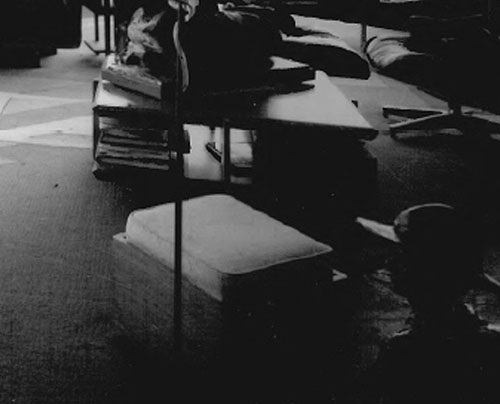 |
| 10) Detail of
the Wright designed coffee table and hassock in the Living
Room. (National Registry of Historic
Places, March 14, 1989, Photography by Richard Collier.) |
| |
 |
| 11) Another
view of the few pieces of Wright designed furniture still
remaining in the Living Room in 1989. A Wright designed
coffee and end tables in the Living Room. Built-in seating
and shelves cover the wall on the right. (National Registry of Historic
Places, March 14, 1989, Photography by Richard Collier.) |
| |
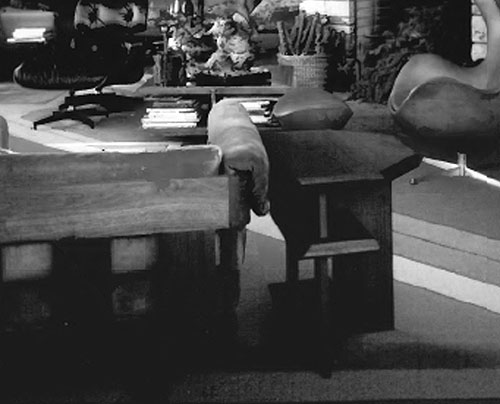 |
| 12) Detail of
the Wright designed coffee and end tables in the Living
Room. (National Registry of Historic
Places, March 14, 1989, Photography by Richard Collier.) |
|
|
|
|
|
|
|
|
|
|
|
|
|
Quintin & Ruth Blair and the Yellowstone Canyon Hotel |
|
|
|
The Blairs collected prairie styled
art glass light fixtures and dining room chairs
from the demolished
Yellowstone Canyon Hotel. One of the double stained
glass light fixtures is mounted on a stone pedestal in the
front yard and the second is on a pedestal in the Garden
Court. A smaller set of single stained glass wall mounted
light fixtures are mounted on either side of the entrance to
the Blair’s Holiday Inn in Cody Wyoming. The Wright designed
dining room chairs were replaced with prairie styled chairs
they acquired from the
Yellowstone Canyon Hotel.
According to Tamsen Emerson
Hert in "Luxury in the Wilderness, Yellowstone’s Grand
Canyon |
|
Hotel, 1911–1960", published in
Yellowstone
Science, Summer 2005, pages
21-35, "Quinn Blair and his wife Ruth, of Cody, Wyoming,
have Canyon Hotel light fixtures adorning their Frank Lloyd
Wright home (the only Wright building in Wyoming), as does
the Holiday Inn in Cody. The Blairs also purchased a set of
Limbert chairs from the president of the Yellowstone Park
Company for $5 apiece at Mammoth Hot Springs."
The chairs in the Blair's
dining room are pictured in a photograph by F. J. Hayners in
"A Miracle in Hotel Building. Yellowstone Canyon
Hotel" by John Henry Raftery published circa 1911,
page 14. |
|
|
 |
|
1) One of the double stained glass light fixtures from the demolished
Yellowstone Canyon Hotel is mounted on a stone pedestal in the
front yard. |
|
|
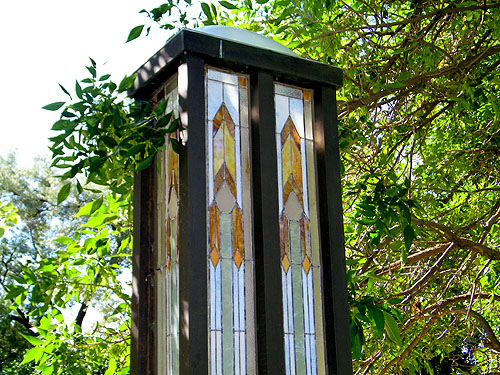 |
|
2) Detail of the double stained glass light fixtures from the demolished
Yellowstone Canyon Hotel mounted on a stone pedestal in the
front yard. |
|
|
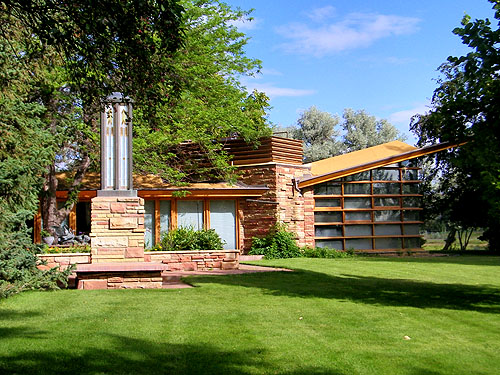 |
|
3) The second double stained glass light fixtures from the demolished
Yellowstone Canyon Hotel is mounted on a stone pedestal
in the Garden Court. |
|
|
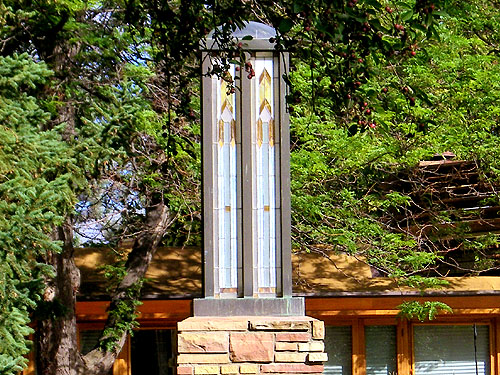 |
|
4) Detail of the double
stained glass light fixtures from the demolished
Yellowstone Canyon Hotel mounted on a stone pedestal in
the Garden Court. |
|
|
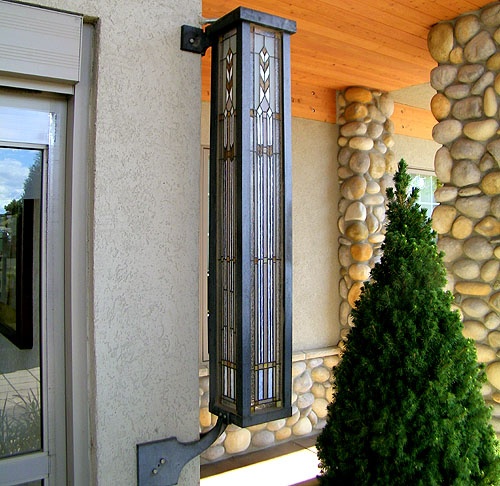 |
|
5) The smaller set of single
stained glass wall mounted light fixtures from the demolished
Yellowstone Canyon Hotel are mounted on either side of
the entrance to the Blair’s Holiday Inn in Cody Wyoming. |
|
|
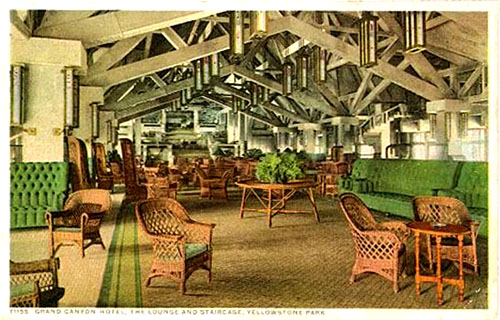 |
|
6)
Yellowstone Canyon Hotel Postcard: "Grand Canyon Hotel,
The Lounge and Staircase, Yellowstone Park." The double
stained glass light fixtures are seen hanging from the
ceiling. The single stained glass wall mounted light
fixtures are seen mounted to each column on the left and
right side of the lounge. |
|
|
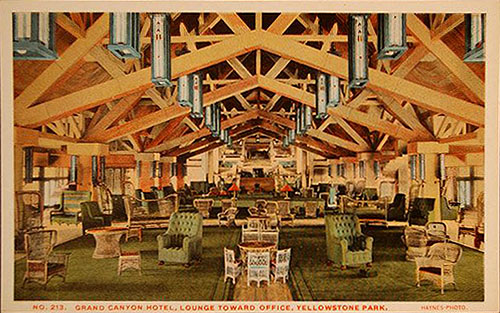 |
|
7)
Yellowstone Canyon Hotel Postcard No.213: "Grand Canyon
Hotel, The Lounge Toward Office, Yellowstone Park." The
double stained glass light fixtures are seen hanging from
the ceiling. The single stained glass wall mounted light
fixtures can be seen mounted to each column on the left and
right side of the lounge. |
|
|
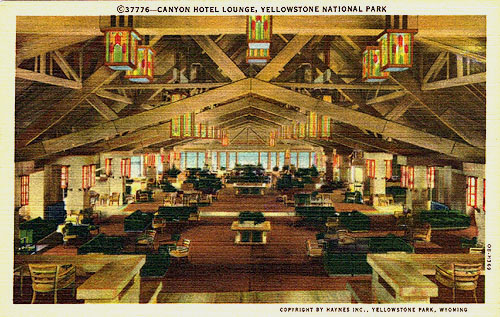 |
|
8) "Canyon Hotel Lounge, Yellowstone National Park
(c) 37776. Copyright by Haynes Inc., Yellowstone Park, Wyoming. OB-H369."
Back: "Canyon Hotel Lounge, one of the show places of the park, is the front
wing of the hotel situated on the north side of the Grand Canyon. Copyright
by Haynes Inc., Yellowstone Park, Wyoming, U.S.A. Genuine Curteich-Chicago "C.T.
Art-Colortone" Post Card (Reg. U.S. Pat. Off.) [Place one cent stamp here]"
5.5 x 3.5. 1940. |
|
|
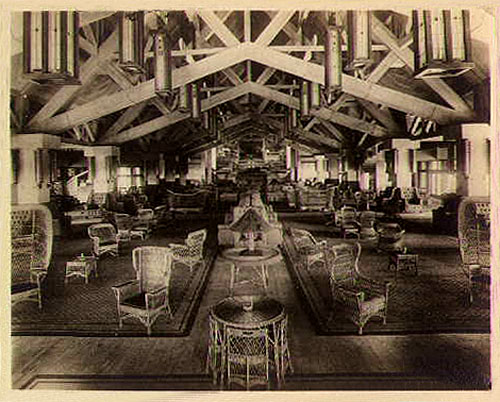 |
|
9)
Yellowstone Canyon Hotel Lounge Circa 1920. The double
stained glass light fixtures are seen hanging from the
ceiling. The single stained glass wall mounted light
fixtures can be seen mounted to each column on the left and
right side of the lounge. |
|
|
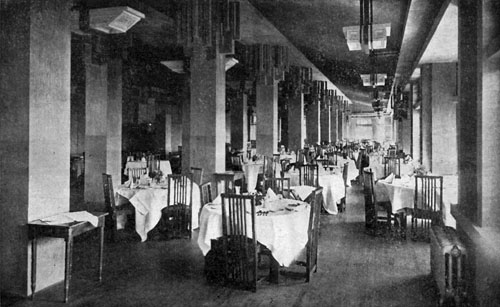 |
|
10)
Yellowstone Canyon Hotel Dining Room Circa 1911. The
Blair's Dining Room is seen in "Frank
Lloyd Wright: The Western Work" Legler, 1999, page 62.
This photograph by
F. J. Hayners was published in "A Miracle in Hotel Building. Yellowstone Canyon
Hotel" by John Henry Raftery, circa 1911,
page 14. |
|
|
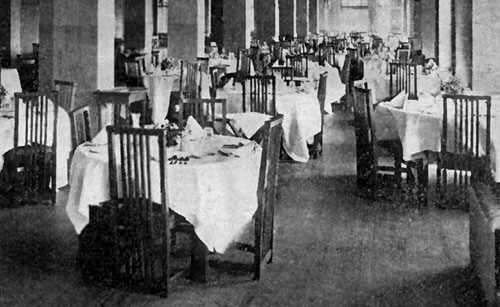 |
|
11) Detail:
Yellowstone Canyon Hotel Dining Room Circa 1911. The
Blair's Dining Room is seen in "Frank
Lloyd Wright: The Western Work" Legler, 1999, page 62.
This photograph by
F. J. Hayners was published in "A Miracle in Hotel Building. Yellowstone Canyon
Hotel" by John Henry Raftery, circa 1911,
page 14. |
|
|
|
|
|
|
|
|
|
|
|
Yellowstone Canyon Hotel |
|
|
|
|
The Blairs collected prairie styled
art glass light fixtures and dining room chairs
from the demolished
Yellowstone Canyon Hotel. One of the double stained
glass light fixtures is mounted on a stone pedestal in the
front yard and the second is on a pedestal in the Garden
Court. A smaller set of single stained glass wall mounted
light fixtures are mounted on either side of the entrance to
the Blair’s Holiday Inn in Cody Wyoming. The Wright designed
dining room chairs were replaced with prairie styled chairs
they acquired from the
Yellowstone Canyon Hotel. |
|
|
|
FIRST
CANYON HOTEL FRANK J.
HAYNES
ROBERT REAMER
ARTICLES BOOKS
PHOTOGRAPHS
POSTCARDS |
|
|
|
|
|
FIRST CANYON HOTEL |
|
The first Yellowstone
Canyon Hotel was built in 1890. In 1910 it was
incorporated into the second Canyon Hotel which was designed
by Architect Robert Reamer. |
|
|
|
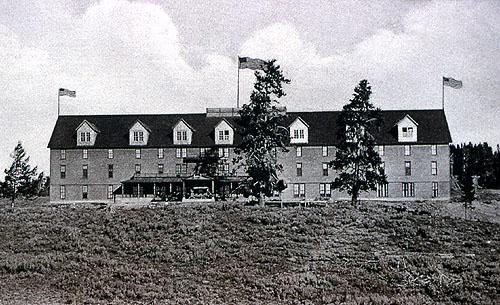 |
|
"Grand Canyon Hotel -
Yellowstone Park. Haynes-Photo. Made in Germany." Postcard
of first Canyon Hotel, photographed by Frank J Haynes, circa
1891. |
|
|
|
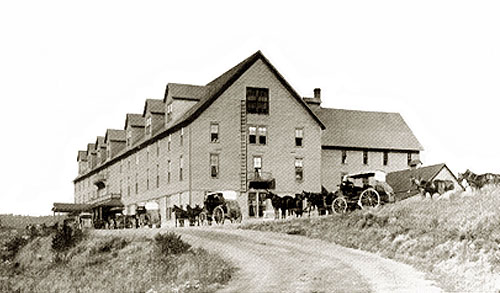 |
|
Guests arriving by stagecoach
at the Grand Canyon Hotel. |
|
|
|
|
|
FRANK J. HAYNES |
|
Frank J.
(Jay) Haynes was born Oct. 28, 1853 in Saline
Michigan and married Lily Verna Synder in 1878. He was known
as the official photographer of the Northern Pacific
Railroad and Yellowstone National Park. He was employed by
the Northern Pacific RR in 1875 to take pictures along their
route from Minnesota to the West Coast for advertising and
promotional purposes. Haynes established a photo studio in
Moorhead, Minnesota in 1876 and moved it to Fargo, North
Dakota in 1879. Ten years later he moved the studio to St.
Paul, Minnesota where it was maintained for many years. In
1884 he obtained leases at both Old Faithful and Mammoth,
where he opened his first photo shop in 1884. The Haynes
Guidebook was first published in 1890 and continued until
1966. In 1900 he produced his first set of ‘picture post
cards’, and went on to produce thousands of post cards. In
1911-12 he photographed the Yellowstone Canyon Hotel, and
his images where published in "A Miracle in Hotel Building,
Being the Story of the Building of the New Canyon Hotel In
Yellowstone Park". Many of these historic images were also
published as postcards. He passed away on March 10, 1921 at
age 68. |
|
|
|
|
|
ROBERT REAMER |
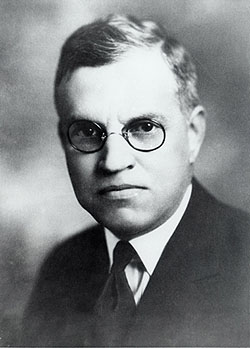 Robert
C. Reamer (1873-1938) was an
American architect, most noted for the Old Faithful Inn
in Yellowstone National Park. Reamer was born in and
spent his early life in Oberlin, Ohio. He left home at
the age of thirteen and went to work in an architect's
office in Detroit as a draftsman. By the age of
twenty-one, Reamer had moved to San Diego and had opened
the architectural office of Zimmer & Reamer in
partnership with Samuel B. Zimmer. The firm produced a
wide variety of projects, but the only surviving example
of Zimmer & Reamer's work is the George H. Hill Block in
the Gaslamp District. The partnership dissolved in 1898,
but Reamer continued to work on his own, including work
at the Hotel del Coronado. During this period he became
acquainted with the president of the Yellowstone Park
Association, Harry W. Child. Robert
C. Reamer (1873-1938) was an
American architect, most noted for the Old Faithful Inn
in Yellowstone National Park. Reamer was born in and
spent his early life in Oberlin, Ohio. He left home at
the age of thirteen and went to work in an architect's
office in Detroit as a draftsman. By the age of
twenty-one, Reamer had moved to San Diego and had opened
the architectural office of Zimmer & Reamer in
partnership with Samuel B. Zimmer. The firm produced a
wide variety of projects, but the only surviving example
of Zimmer & Reamer's work is the George H. Hill Block in
the Gaslamp District. The partnership dissolved in 1898,
but Reamer continued to work on his own, including work
at the Hotel del Coronado. During this period he became
acquainted with the president of the Yellowstone Park
Association, Harry W. Child.
In 1910 Reamer presented designs for a new hotel
to be located at Canyon Village, adjacent to the Falls
of the Yellowstone and the Grand Canyon of the
Yellowstone, to be known as the Canyon Hotel. This hotel
incorporated portions of a previous hotel, built in
1891, and was 750 feet long with 400 rooms and 100
baths. Occupying a prominent site on a hillside, it was
built in the winter of 1910-1911. The design bore a
close resemblance to Frank Lloyd Wright's Prairie style
work, with a strong horizontal emphasis and a commanding
roof line.
By 1918, Reamer had remarried and relocated to
Seattle. In 1935, Reamer began to experience health
problems that led to the amputation of a leg in 1937. He
died in Seattle of a heart attack on January 7, 1938.
(Wikipedia)
The centerpiece of the Canyon Hotel was its lounge
which had elements of Prairie Styled architecture.
Close to midnight on August
17, 1959 a 7.5 magnatude earthquake struck Yellowstone
National Park centered at Hebgen Lake. Over the next few
hours four aftershocks shook the Yellowstone area, with
magnitudes ranging from 5.8 to 6.5. Damage to the Old
Faithful Lodge was minimal. But the Canyon Hotel did not
fair as well. It suffered extensive damage and the
conclusion was reached that repairs would be to costly.
The Canyon Hotel was ordered razed and demolition began.
But late on August 8,1960 before it could be completely
demolished it caught fire and burned.Extant of Robert
Reamer’s other work:
- Hall's Mercantile, Gardiner, Montana, now the
headquarters of the Yellowstone Association, 1903.
- Old Faithful Inn, Yellowstone National Park, 1904,
additions 1913-1914.
- Lake Yellowstone Hotel, Yellowstone National Park,
expansion, 1904, additions 1923, 1928, 1936.
- Masonic Home, Helena, Montana, 1906.
- H.W. Child House (Executive House), Mammoth Hot
Springs, Yellowstone National Park, 1908.
- Mammoth Hot Springs Hotel addition, Yellowstone
National Park, 1913.
- Union Station, Clinton, Massachusetts, 1914.
-
Lake Quinault Lodge, Quinault, Washington, 1926.
- Skinner Building,
Fifth Avenue Theater, Seattle,
Washington, 1926.
- Mount Baker Theater, Bellingham, Washington, 1927.
- 1411 Fourth Avenue, Seattle, Washington, 1928.
- Edmond Meany Hotel, Seattle, Washington, 1931.
- Fox Theater, Spokane, Washington, 1931.
- Fox Theater (later Alberta Bair Theater), Billings,
Montana, 1931.
Demolished work:
- Northern Pacific Railroad Depot, Gardiner, Montana,
1903, demolished 1954.
- Transportation Building, Mammoth Hot Springs,
Yellowstone National Park, 1903, burned 1925.
- Canyon Hotel, Yellowstone National Park, 1910,
addition 1930, demolished 1962.
- Maine Central Railroad Depot, Augusta, Maine, 1913,
demolished 1961.
Unbuilt designs:
- Mount Washington Summit Hotel, Mount Washington, New
Hampshire, designed 1912.
|
| |
|
ARTICLES |
| |
YELLOWSTONE PARK'S
NEW HOTEL OPENS WITH BALL
Published in The Anaconda Standard, Aug. 4, 1911
Aug. 3 - The formal opening of the New Grand Canyon
hotel in Yellowstone park, which marks the opening of
this $700,000 structure, was celebrated last night by a
ball, in which the guests of the hotel, campers in the
park, fisherman, hotel employees and everybody else
within a radius of 50 miles joined in.
The hotel is unique among
all the resort hotels in the world and the mammoth
lounging room is the most striking feature. This room,
185 feet by 95 feet in dimension, is finished in natural
birch and furnished with large upholstered and willow
pieces of original patterns, designed by Mrs. H. W.
Child.
The hotel, which has been
under construction for more than a year, was opened,
except for the lounging room, when the park season
began, June 15. It was built under incredible
difficulties and every pound of material within this
great structure, which stretches along the mountainside
for 700 feet and is full five stories in height, was
brought in by freight wagon and sleds from Gardner, 40
miles away, and for several months, through snowdrifts
10 to 12 feet in depth, with the thermometer far below
zero for weeks at a time. The hotel has 450 rooms and 75
bathrooms.
Robert C. Reamer, the
architect, spent a year studying the great resort hotels
in Europe and this country before making the plans, but
found nothing suitable for the canyon, and built the new
hotel after ideas of his own. Mr. Reamer was architect
for the Old Faithful Inn and the Lake Colonial hotel in
the park. The hotel sits on the side of the mountain, in
absolute harmony with the natural scenery, within half a
mile of the canyon of the Yellowstone. |
| |
| |
| |
|
|
BOOKS |
|
"A Miracle in Hotel Building, Being the Story of the Building of the New Canyon
Hotel In Yellowstone Park" |
|
Circa 1911 |
|
By Raftery, John Hentry; Photographs by Frank. J. Haynes |
|
|
|
"...The two regiments
of men who spent the winter of 1910-11 building this
marvelous mountain hotel have been practically isolated from
the world for months. They have worked always seven days of
the week ; they had no saloon or club or theater to beguile
their time or bemuse their faculties, and even for the
younger, pleasure-loving workers there was no diversion,
except the fierce thrill of gliding and coasting on skis
over the glacier-like slopes of the desolate amphitheatre
which surrounded them. There is probably no other like
example of hotel-building in history, and the structure
which is the result, the scene which it civilizes without
desecrating, the strange region which it adorns without
vulgarizing are all in keeping and in singular symmetry. ...Rustic it is not, in the sense that Old Faithful Inn is
rustic. Architect Robert C. Reamer, who also contrived and
constructed the historic Old Faithful Inn, smiled gravely
when I commented upon this impressive feature of his latest
and greatest work, saying: "I built it in keeping with the
place where it stands. Nobody could improve upon that. To be
at discord with the landscape, would be almost a crime. To
try to improve upon it, would be an impertinence." |
|
|
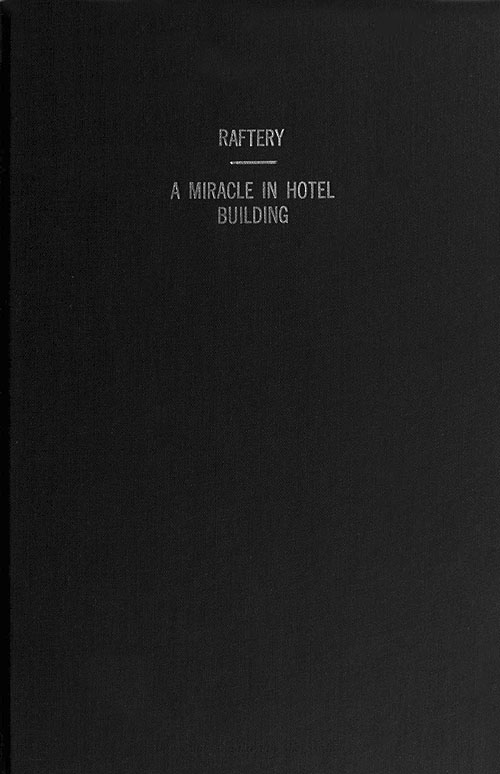 |
|
"A Miracle in Hotel Building, Being the
Story of the Building of the New Canyon Hotel In Yellowstone
Park" Circa 1911. Published by the Yellowstone
Park Hotel Company. Written by John Hentry Raftery, Photographs by
Frank J. Haynes. |
|
|
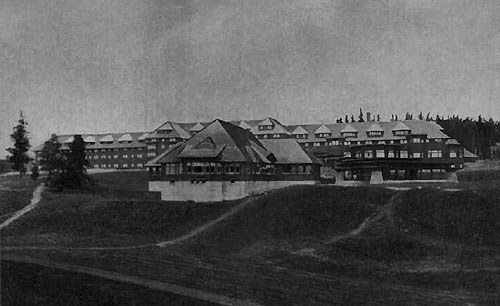 |
|
Yellowstone Park Hotel, circa
1911. Published in "A Miracle in Hotel Building, Being the
Story of the Building of the New Canyon Hotel In Yellowstone
Park" on the inside front cover. Photographed by
Frank J. Haynes. |
|
|
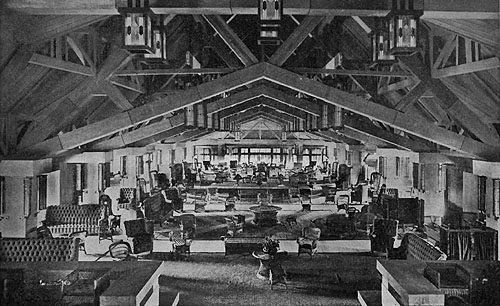 |
|
The Lounge from the Lobby
Steps, circa 1911. Published in "A Miracle in Hotel
Building, Being the Story of the Building of the New Canyon
Hotel In Yellowstone Park" on page 9. Photographed by
Frank J. Haynes. |
|
|
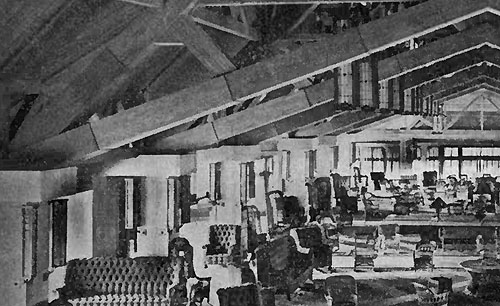 |
|
Detail of the The Lounge
image detailing the hanging and wall mounted light fixtures
the Blairs purchased. Published in "A Miracle in Hotel
Building, Being the Story of the Building of the New Canyon
Hotel In Yellowstone Park" on page 9. Photographed by
Frank J. Haynes. |
|
|
|
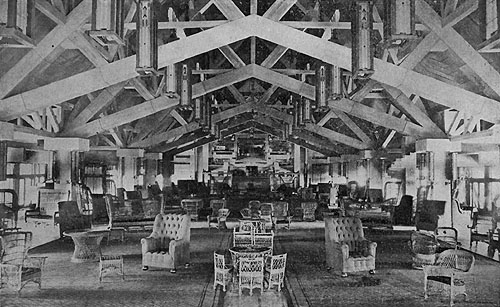 |
|
The Lounge looking toward the
Lobby, circa 1911. Published in "A Miracle in Hotel
Building, Being the Story of the Building of the New Canyon
Hotel In Yellowstone Park" on page 10. Photographed by
Frank J. Haynes. |
|
|
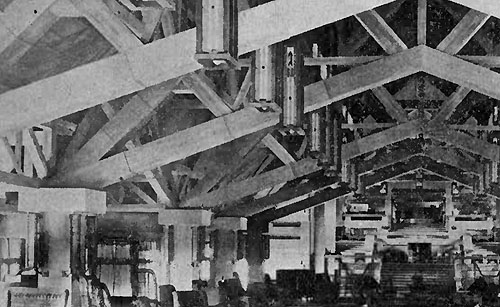 |
|
Detail of the The Lounge
image detailing the hanging and wall mounted light fixtures
the Blairs purchased. Published in "A Miracle in Hotel
Building, Being the Story of the Building of the New Canyon
Hotel In Yellowstone Park" on page 10. Photographed by
Frank J. Haynes. |
|
|
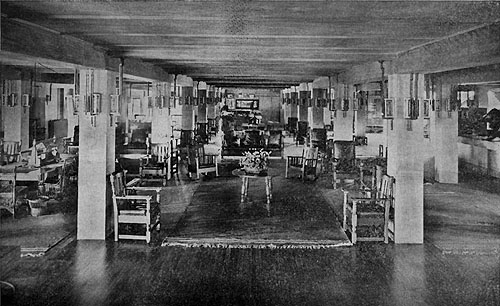 |
|
The Lobby, circa 1911.
Published in "A Miracle in Hotel Building, Being the Story
of the Building of the New Canyon Hotel In Yellowstone Park"
on page 12. Photographed by Frank J.
Haynes. |
|
|
 |
|
The Dining Room, circa 1911.
Published in "A Miracle in Hotel Building, Being the Story
of the Building of the New Canyon Hotel In Yellowstone Park"
on page 14. Photographed by Frank J.
Haynes. |
|
|
 |
|
Detail of the The Dining Room
image detailing the dining room chairs the Blairs purchased.
Circa 1911. Published in "A Miracle in Hotel Building, Being
the Story of the Building of the New Canyon Hotel In
Yellowstone Park" on page 14. Photographed by
Frank J. Haynes. |
|
|
|
|
|
|
PHOTOGRAPHS |
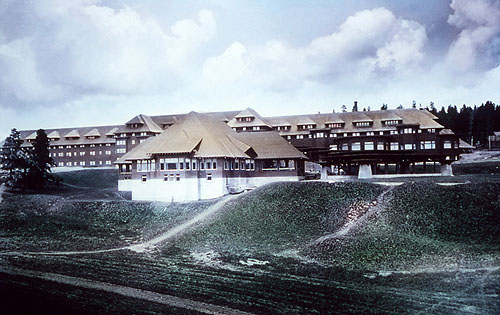 |
| Canyon
Hotel, Yellowstone National Park. Courtesy of the National
Park Service. J.P. Clum lantern slide. Circa 1911. Published
in "A Miracle in Hotel Building, Being the Story of the
Building of the New Canyon Hotel In Yellowstone Park" on the
inside front cover. Photographed by
Frank J. Haynes. |
| |
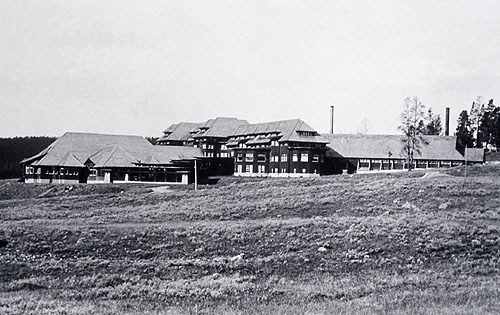 |
|
Canyon Hotel, Yellowstone
National Park. Courtesy of the National Park Service. Circa
1917. Photographed by Frank J. Haynes. |
| |
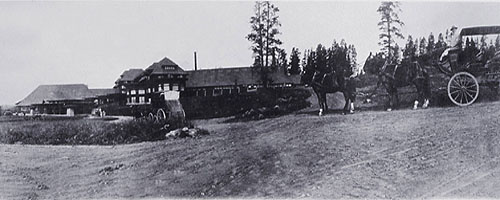 |
|
Guests arriving by stagecoach at
the Yellowstone Canyon Hotel. Courtesy of the National Park
Service. |
| |
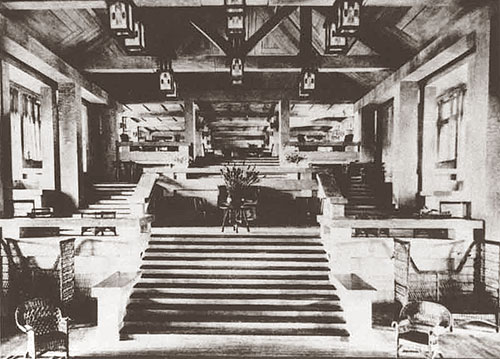 |
|
The Canyon Hotel, stairway and
musicians' stage at end of main lounge. |
| |
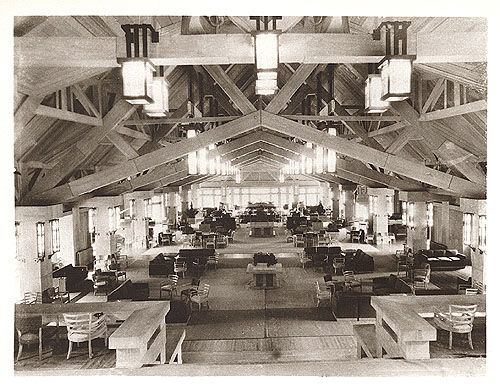 |
|
Canyon Hotel Lounge, Yellowstone
National Park #37776. Photographed by
Frank J. Haynes. |
| |
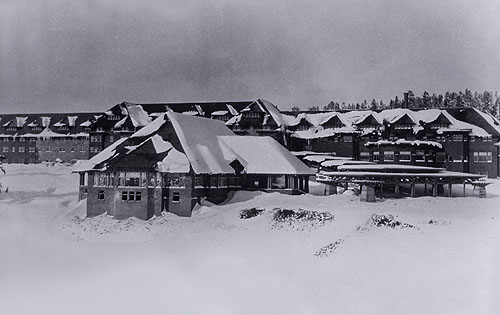 |
|
Canyon Hotel, Yellowstone
National Park, circa 1917. Courtesy of the National Park
Service. |
| |
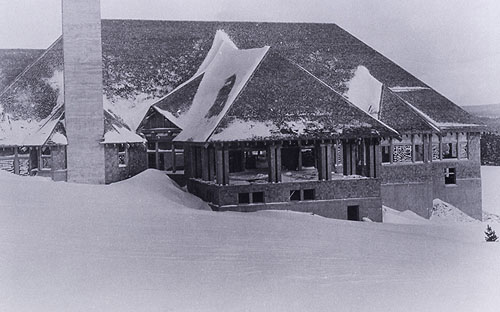 |
|
Canyon Hotel, Yellowstone
National Park, circa 1917. Courtesy of the National Park
Service. |
| |
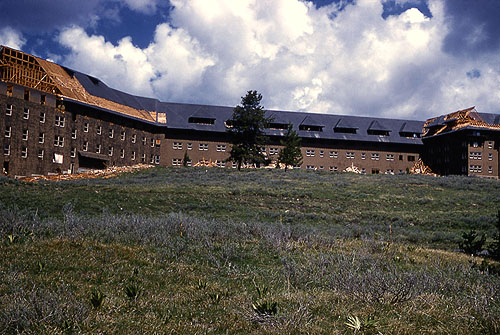 |
|
Demolition of the Canyon Hotel. Close to midnight on August
17, 1959 a 7.5 magnatude earthquake struck Yellowstone
National Park centered at Hebgen Lake. Over the next few
hours four aftershocks shook the Yellowstone area. Damage to
the Canyon Hotel was severe. It suffered extensive damage
and the conclusion was reached that repairs would be to
costly. Possibly photographed by Michael Turner, Haynes
Photo Shop. Courtesy of the National Park Service. |
| |
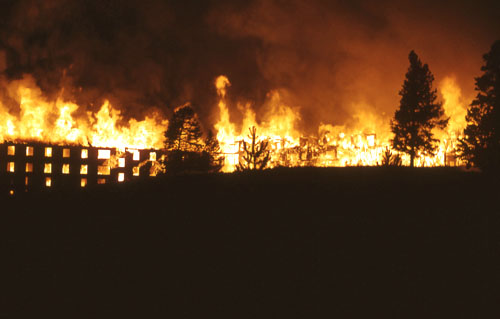 |
|
Destruction of the Canyon Hotel.
Late on August 8,1960 before it could be completely
demolished it caught fire and burned. Possibly
photographed by Michael Turner, Haynes Photo Shop. Courtesy
of the National Park Service. |
| |
| |
|
|
POSTCARDS |
| |
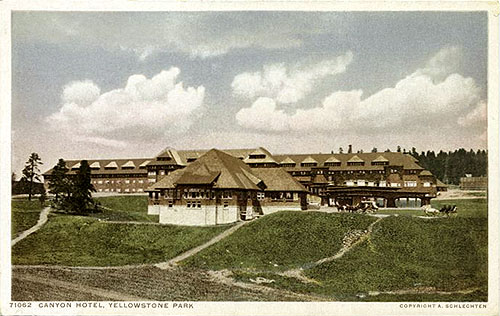 |
| "71062
Canyon Hotel, Yellowstone Park. Copyright A. Schlechten".
Stagecoaches in front of the Yellowstone Canyon Hotel, circa
1914. |
| |
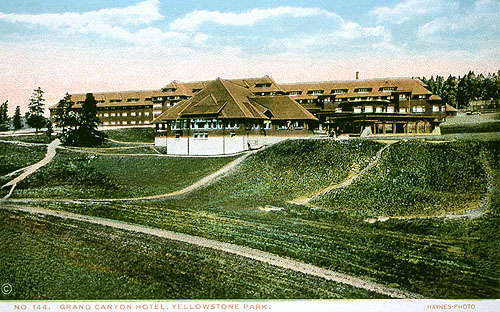 |
| "No
144. Grand Canyon Hotel, Yellowstone Park. Haynes Photo". |
| |
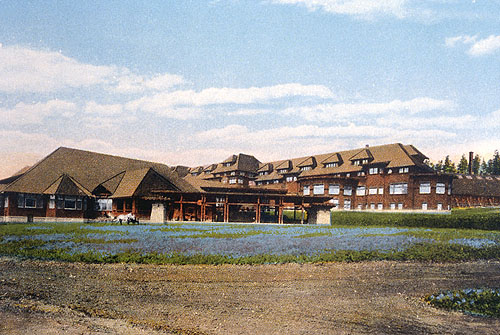 |
| Canyon
Hotel, Yellowstone National Park, By Asahel Curtis,, Circa
1928. |
| |
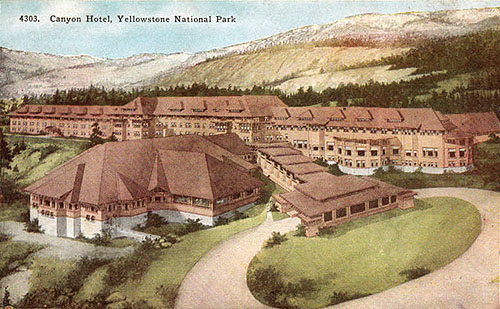 |
| "4303.
Canyon Hotel, Yellowstone Park." |
| |
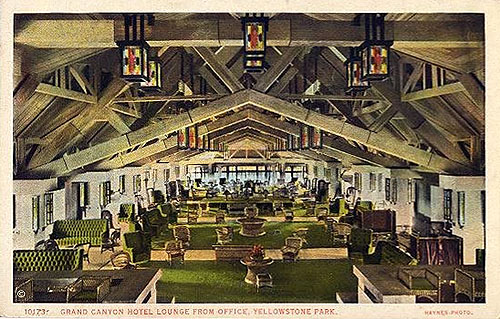 |
| "10173.
Grand Canyon Hotel Lounge from Office, Yellowstone Park.
Haynes Photo." Circa 1911. Published in "A Miracle in Hotel Building, Being the Story of the
Building of the New Canyon Hotel In Yellowstone Park" on page 9.
Photographed by Frank J. Haynes. |
| |
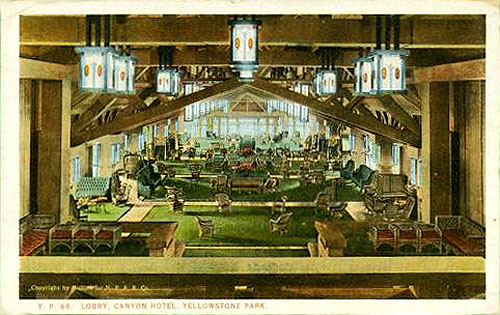 |
| "Y.
P. 68. Lobby, Canyon Hotel, Yellowstone Park. Copyright N.
P. R. R. Co." |
| |
 |
|
"Canyon Hotel Lounge, Yellowstone National Park
(c) 37776. Copyright by Haynes Inc., Yellowstone Park, Wyoming. OB-H369."
Back: "Canyon Hotel Lounge, one of the show places of the park, is the front
wing of the hotel situated on the north side of the Grand Canyon. Copyright
by Haynes Inc., Yellowstone Park, Wyoming, U.S.A. Genuine Curteich-Chicago "C.T.
Art-Colortone" Post Card (Reg. U.S. Pat. Off.) [Place one cent stamp here]"
5.5 x 3.5. 1940. |
| |
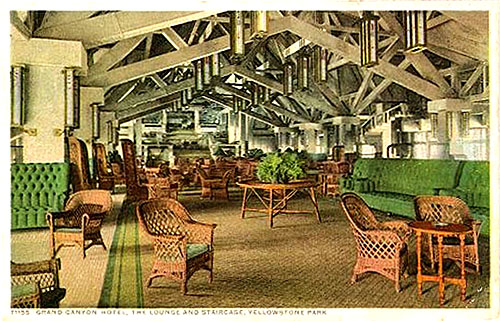 |
| "T1155,
Grand Canyon Hotel, The Lounge and Staircase, Yellowstone Park." |
| |
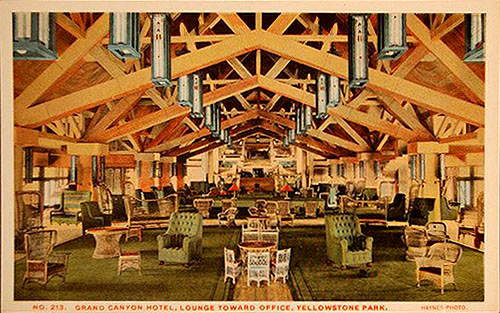 |
| "No
213, Grand Canyon Hotel, Lounge Toward Office, Yellowstone Park.
Haynes Photo" Published in "A Miracle in Hotel Building, Being the Story of the
Building of the New Canyon Hotel In Yellowstone Park" on page 10. Photographed by
Frank J. Haynes. |
| |
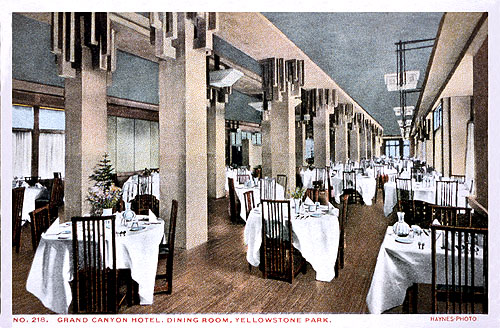 |
| "No
218, Grand Canyon Hotel, Dining Room, Yellowstone Park.
Haynes Photo" |
|
|
|
|
|
|
|
|
|
|
|
|

PROCEEDS FROM EVERY SALE GOES TO SUPPORT THE WRIGHT LIBRARY.

Robert C. Reamer (1873-1938) was an American architect, most noted for the Old Faithful Inn in Yellowstone National Park. Reamer was born in and spent his early life in Oberlin, Ohio. He left home at the age of thirteen and went to work in an architect's office in Detroit as a draftsman. By the age of twenty-one, Reamer had moved to San Diego and had opened the architectural office of Zimmer & Reamer in partnership with Samuel B. Zimmer. The firm produced a wide variety of projects, but the only surviving example of Zimmer & Reamer's work is the George H. Hill Block in the Gaslamp District. The partnership dissolved in 1898, but Reamer continued to work on his own, including work at the Hotel del Coronado. During this period he became acquainted with the president of the Yellowstone Park Association, Harry W. Child.



























































